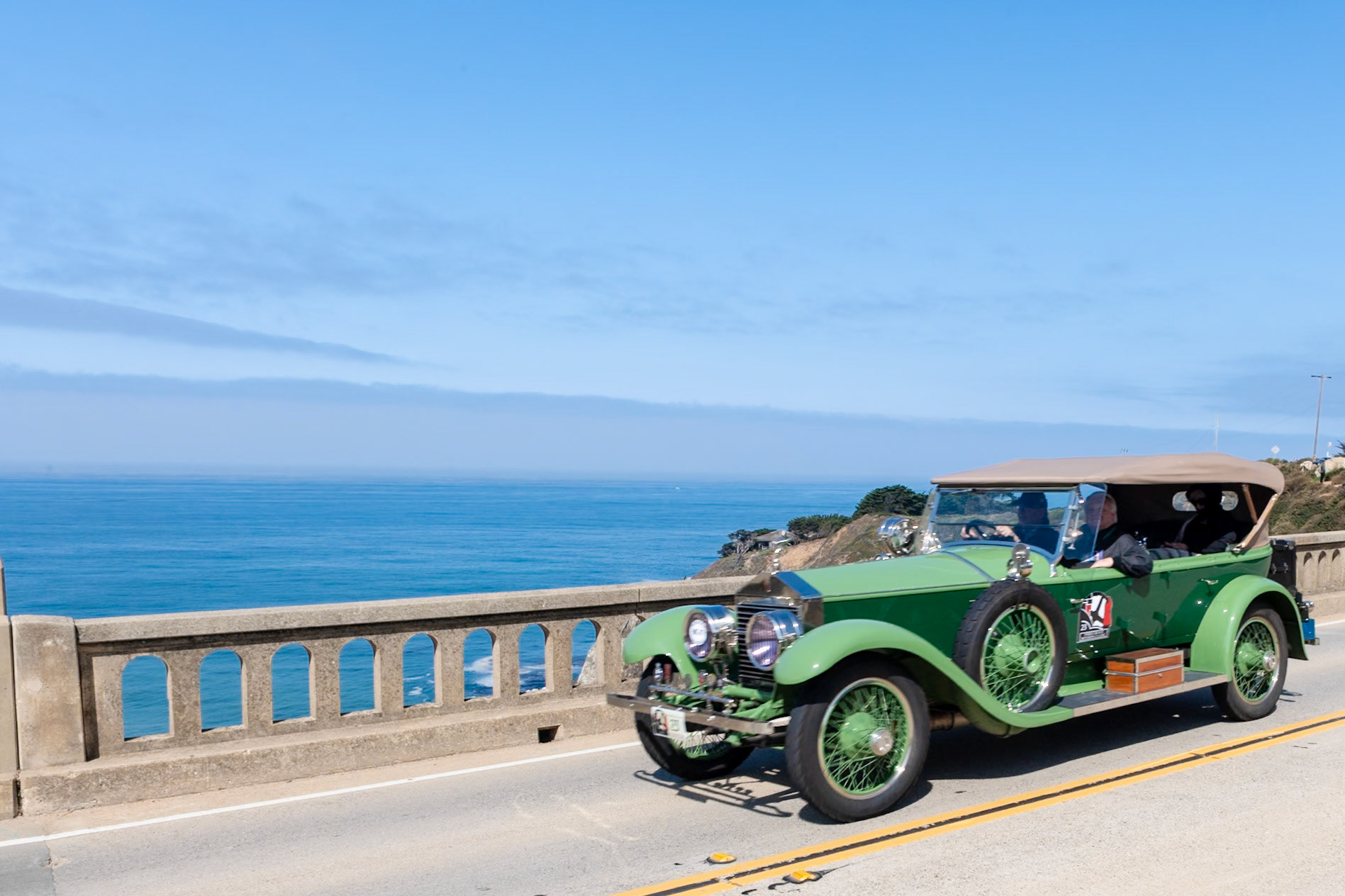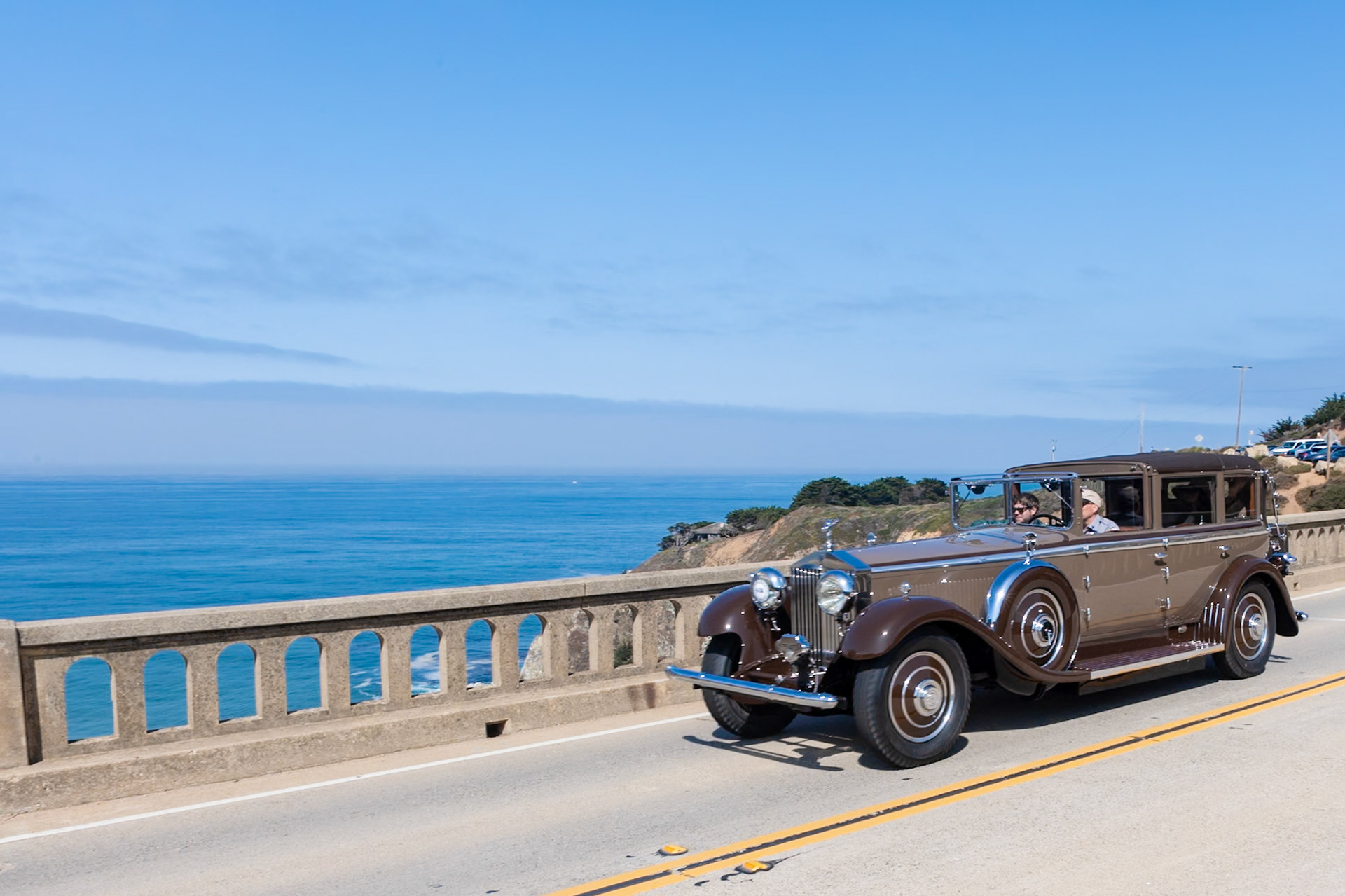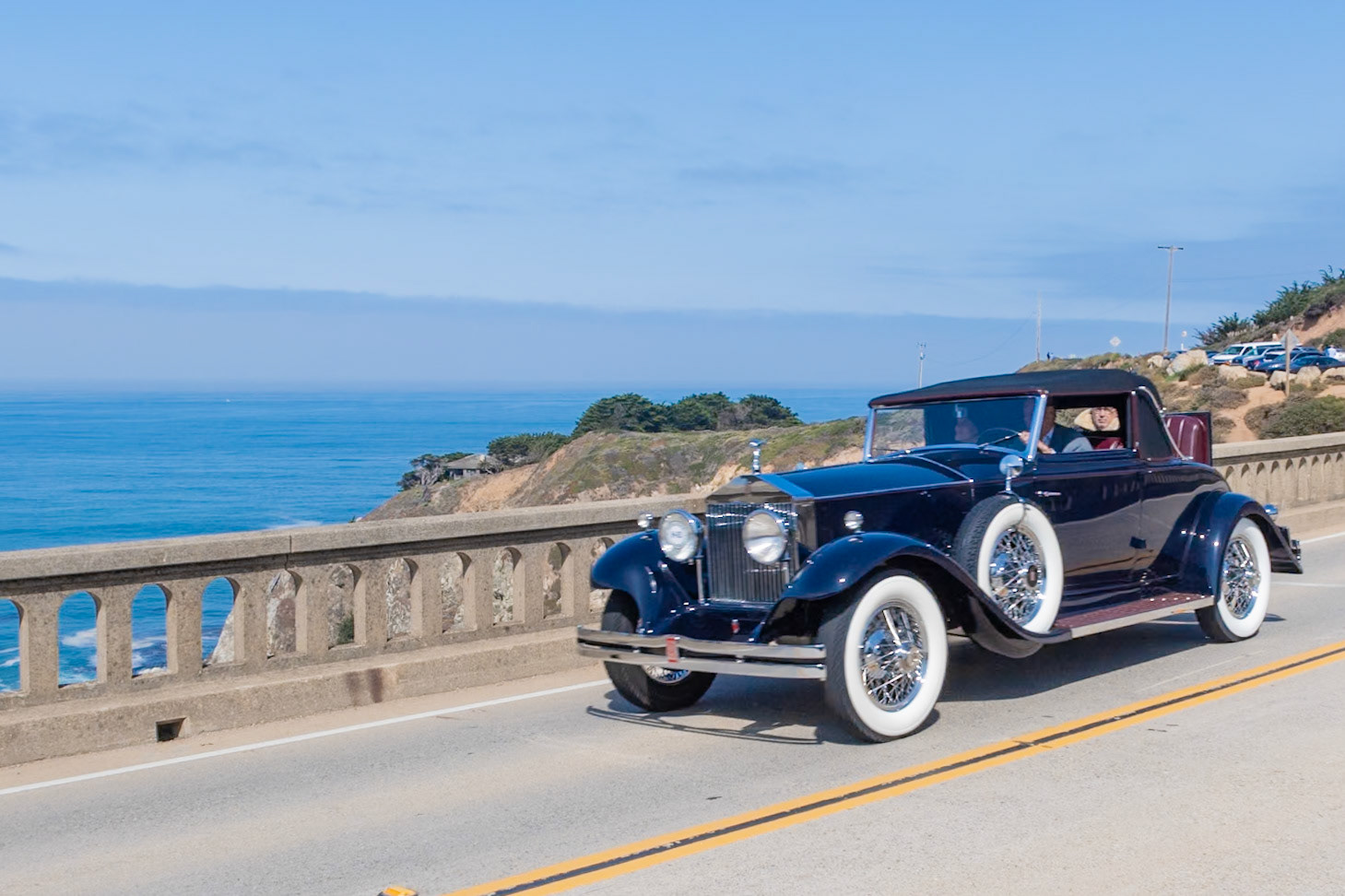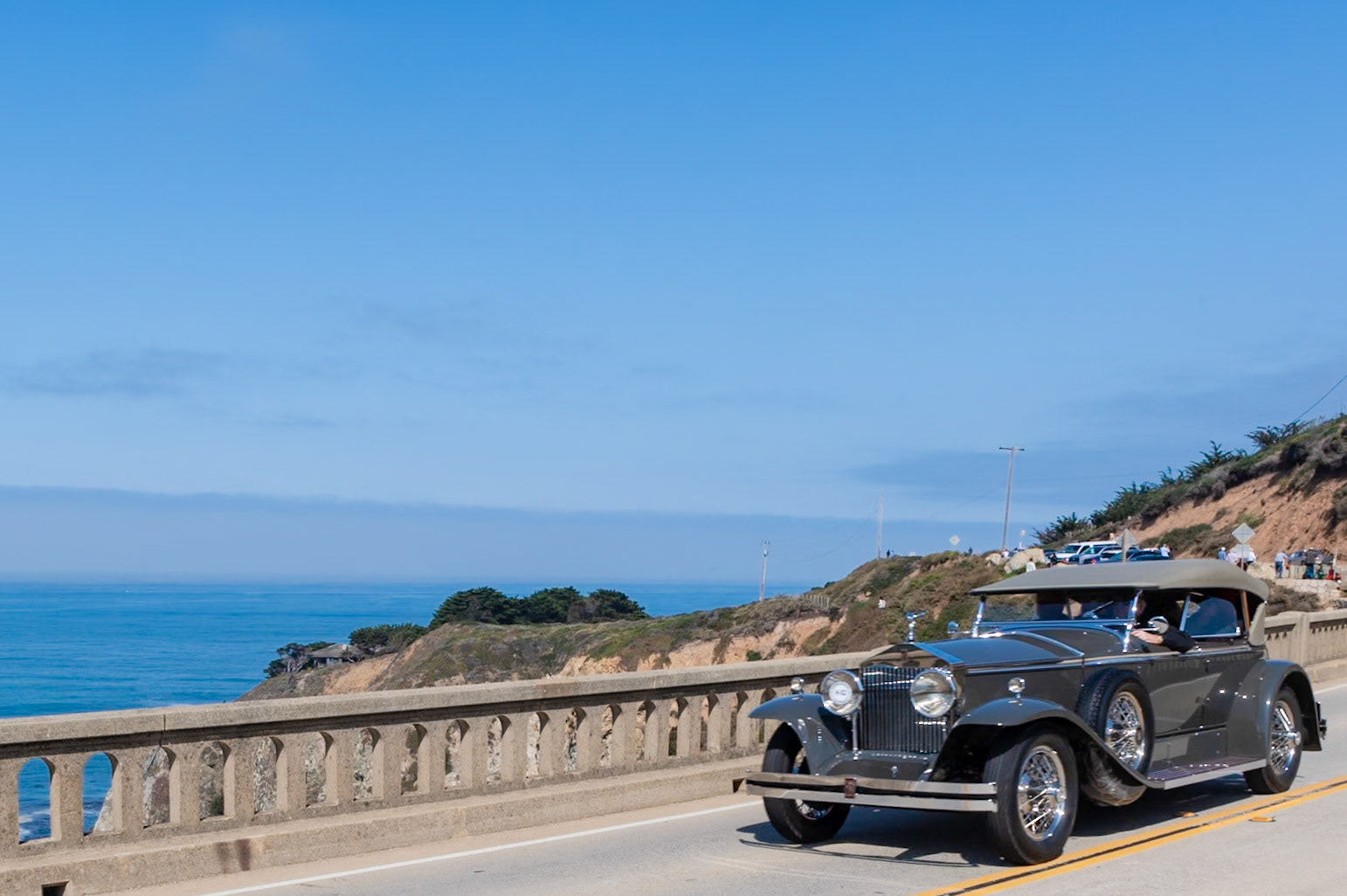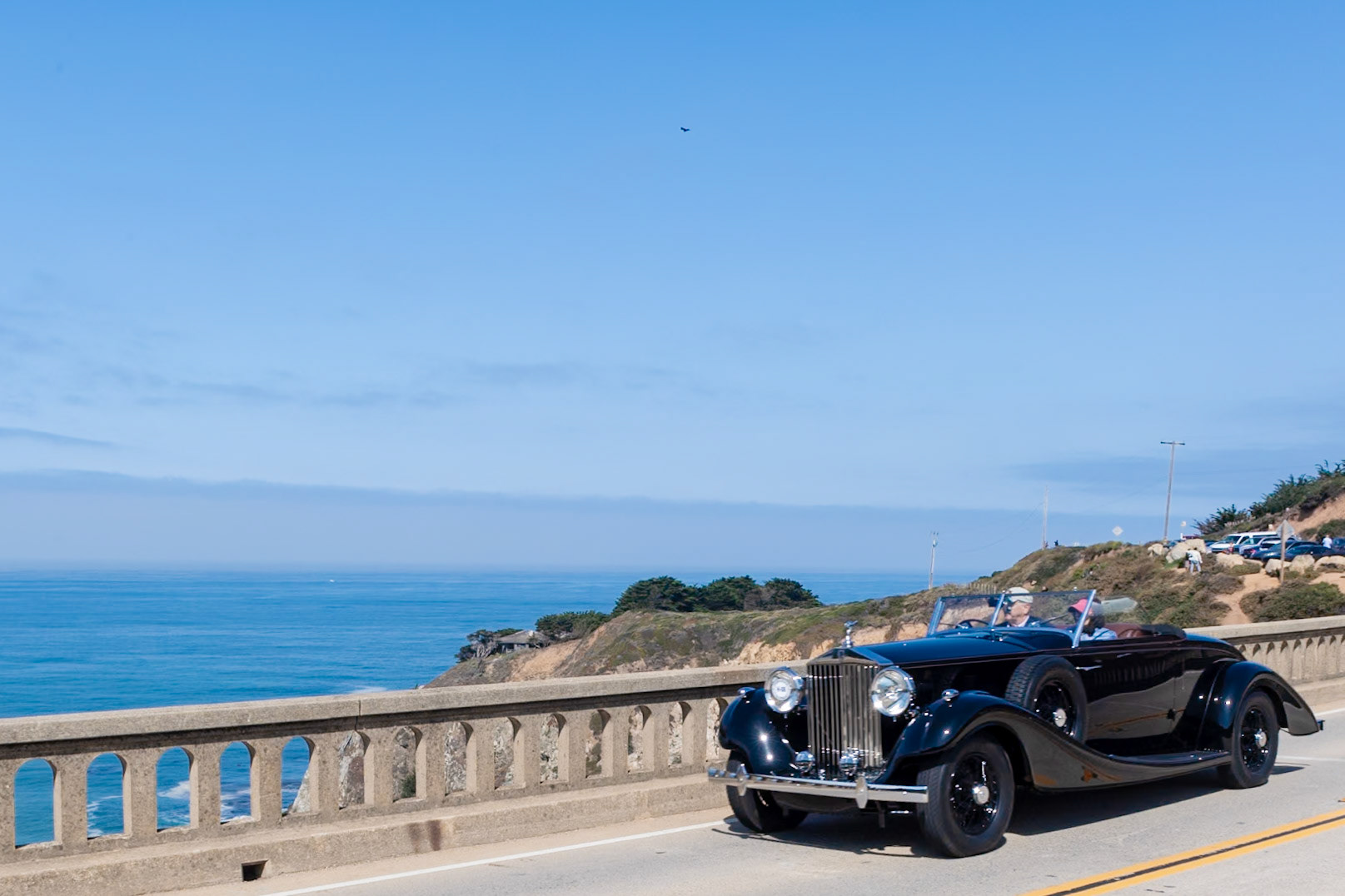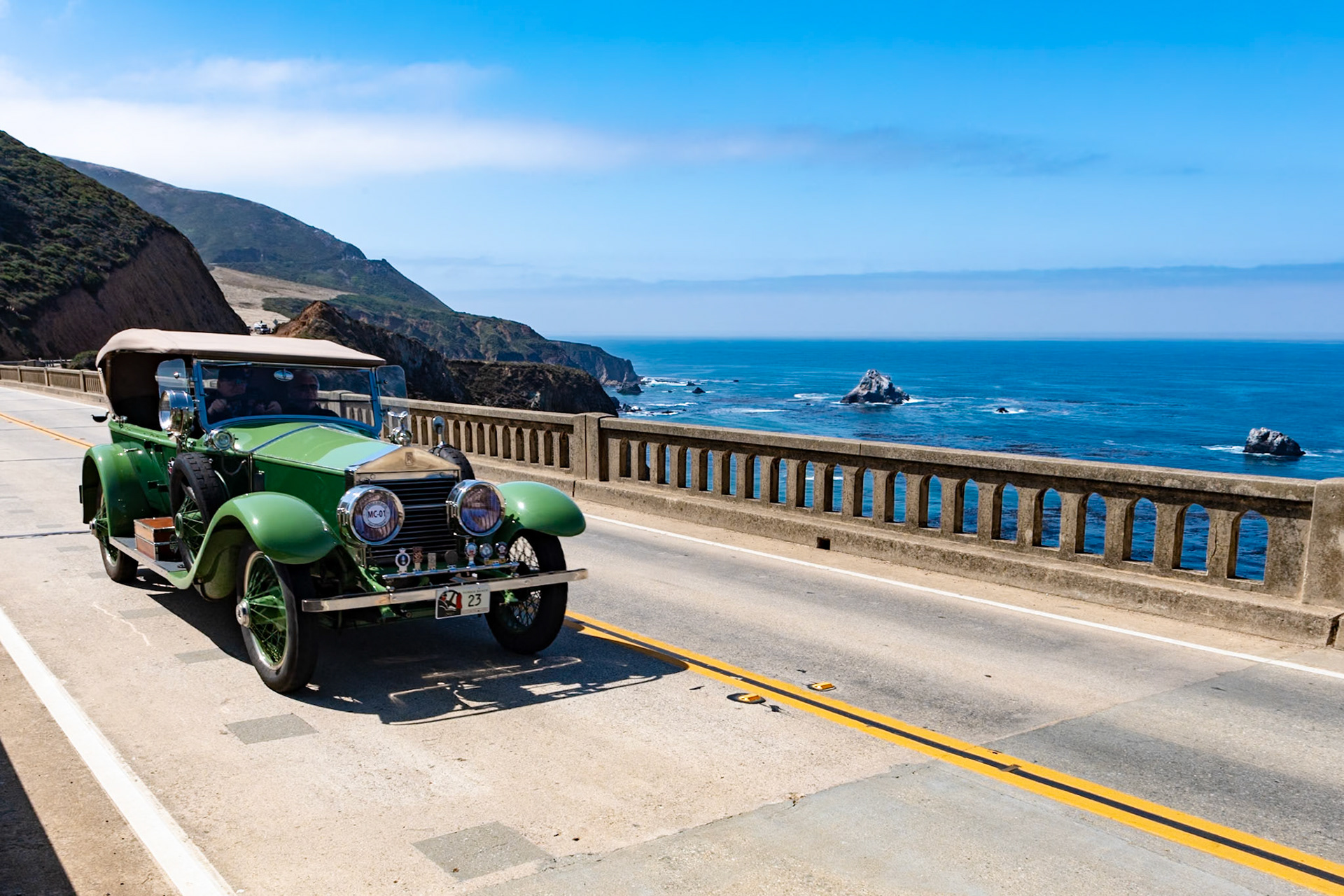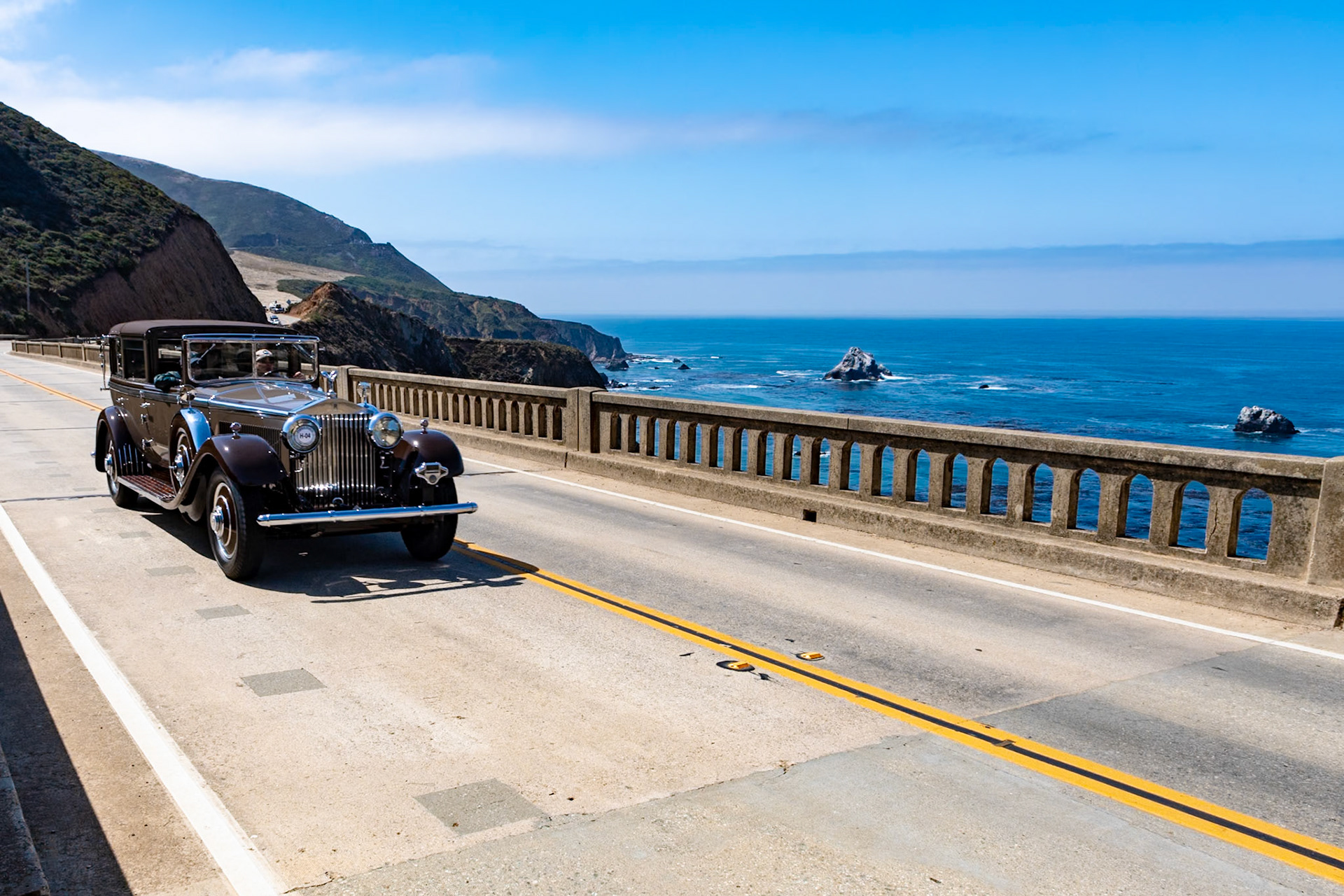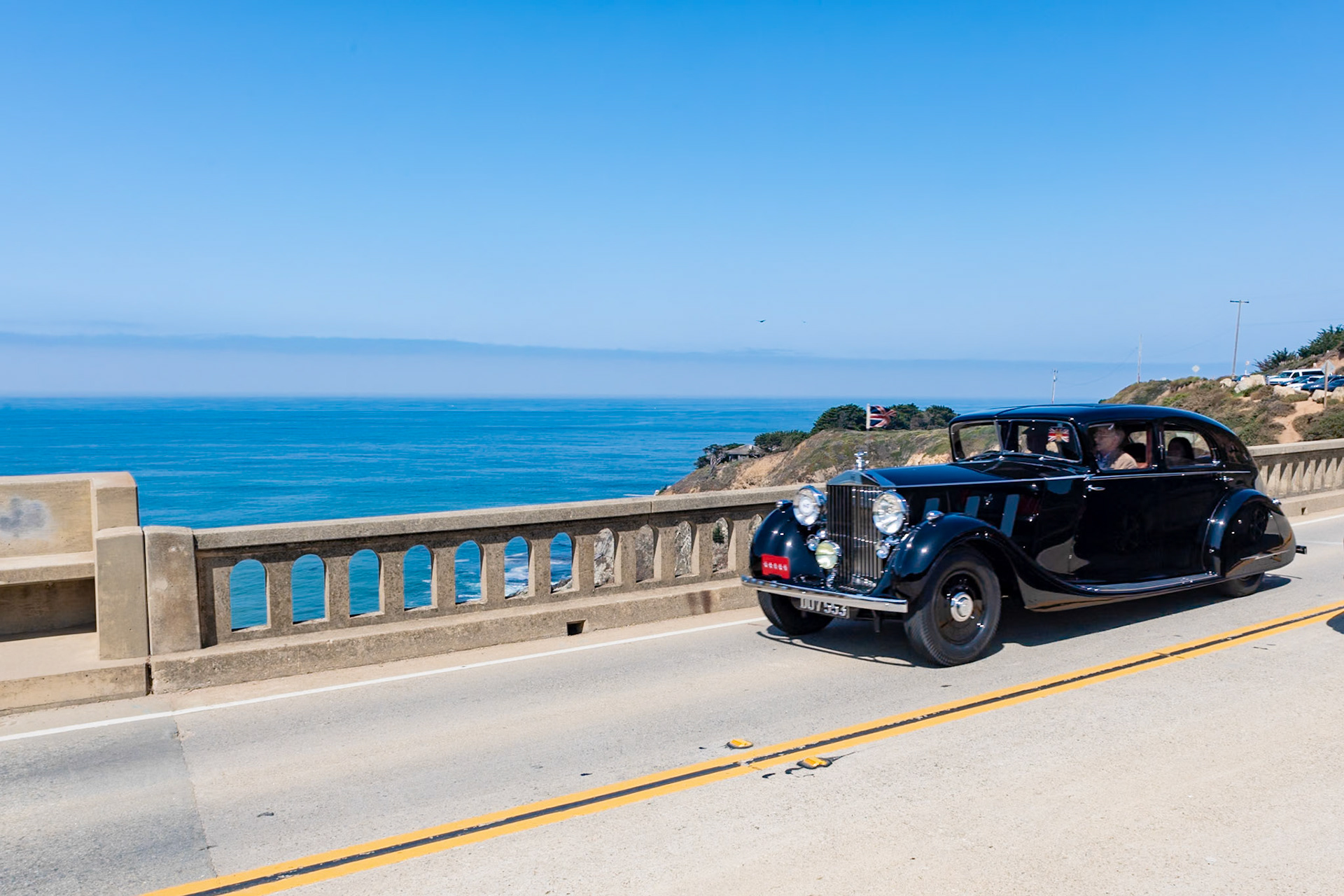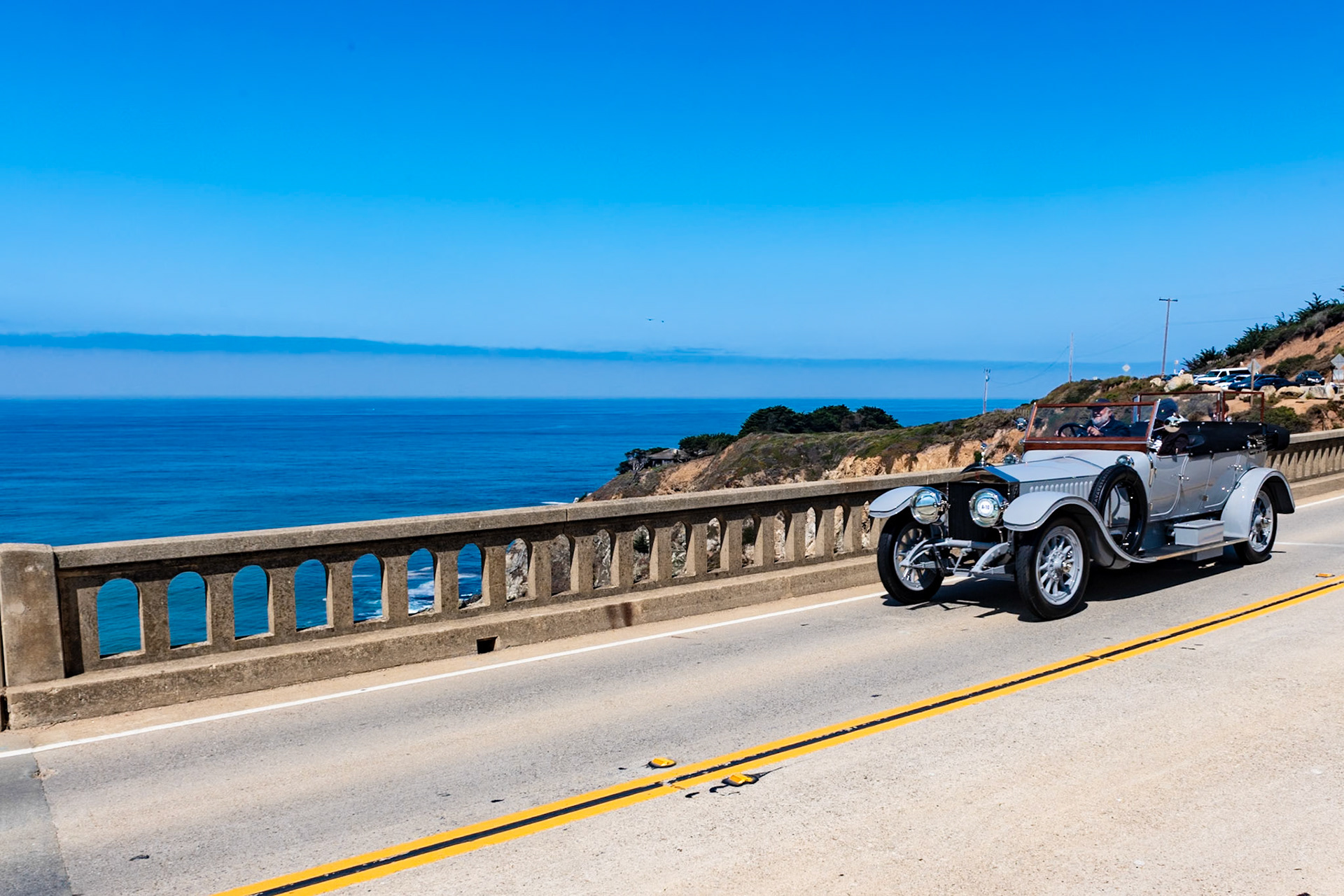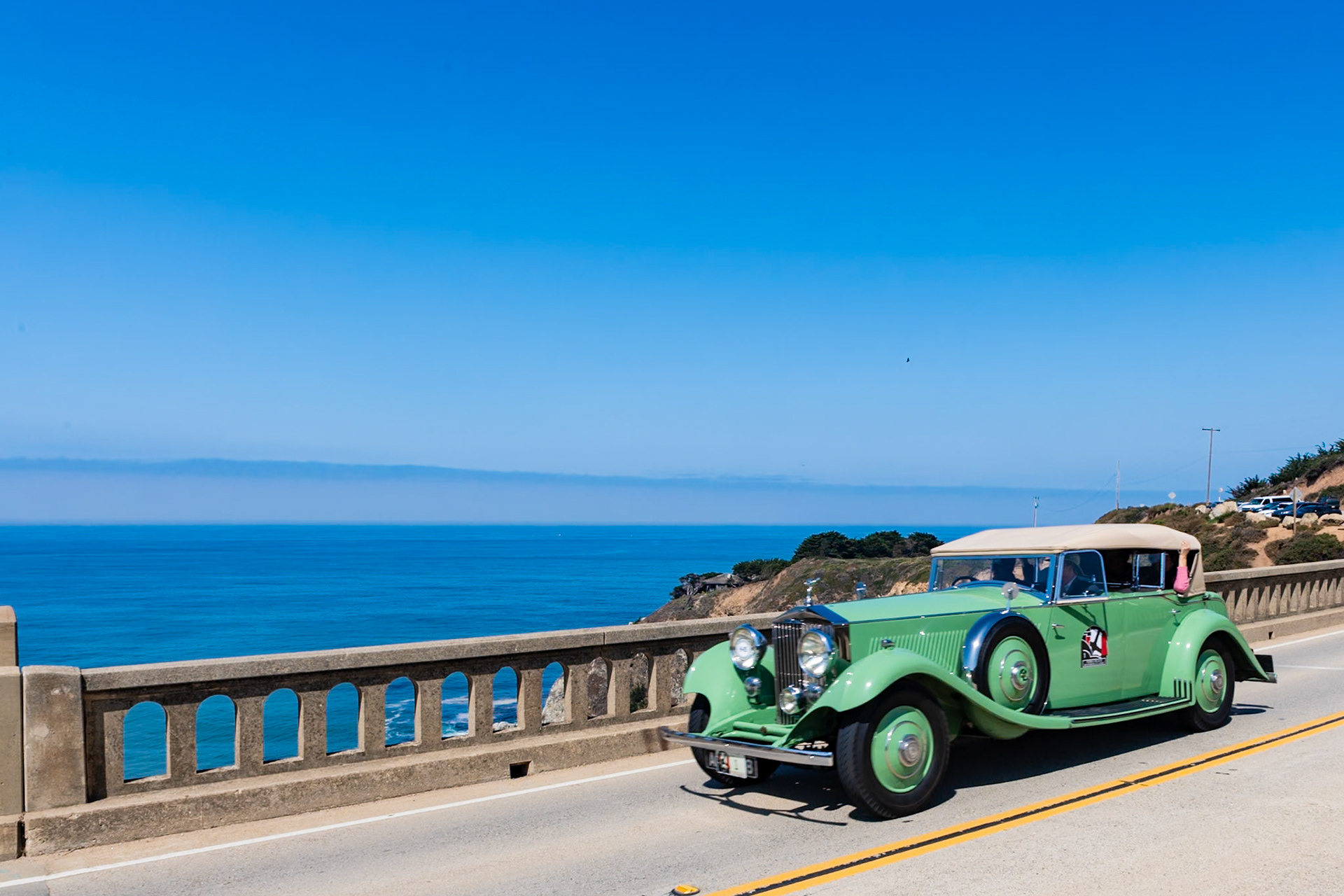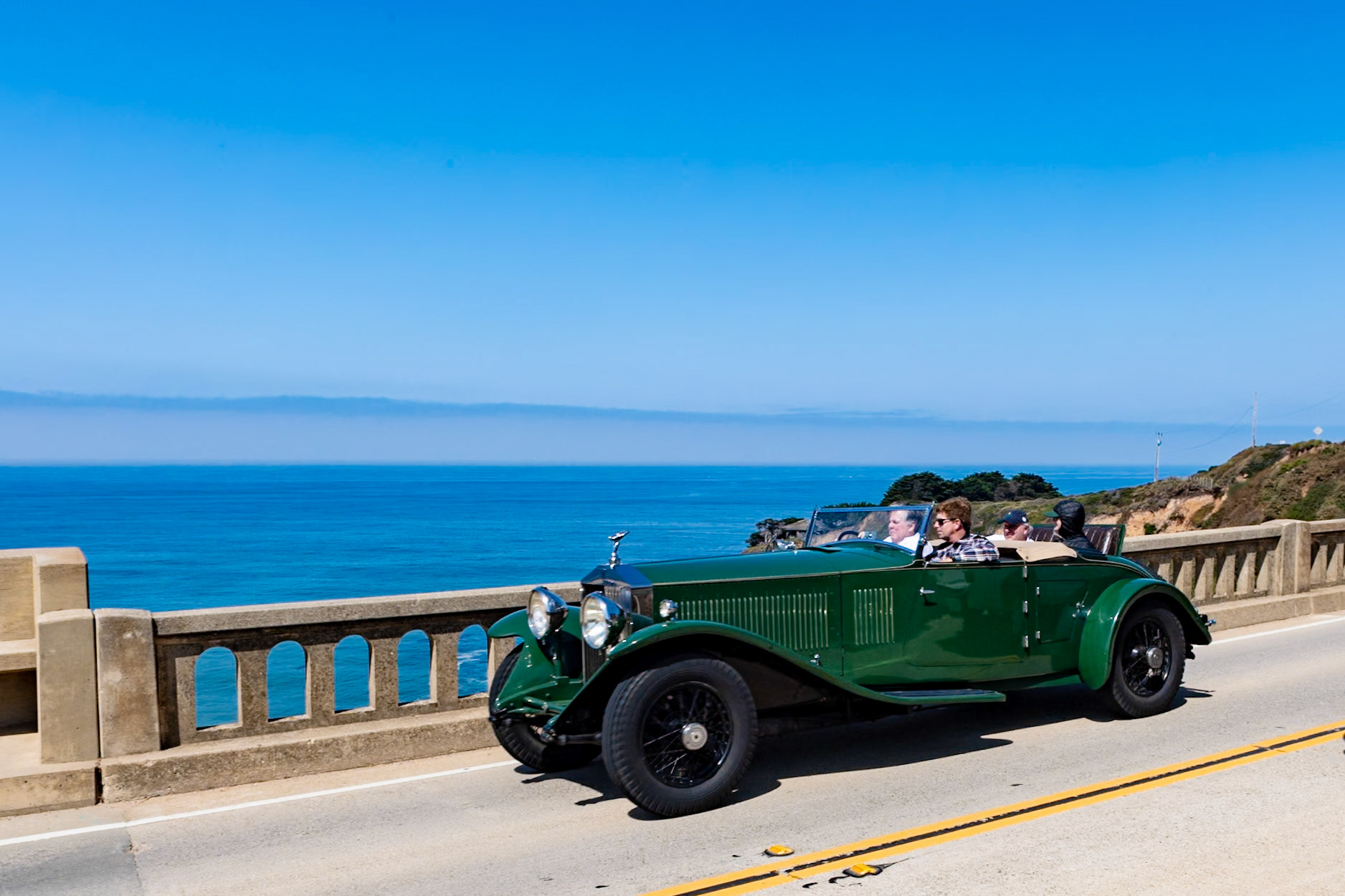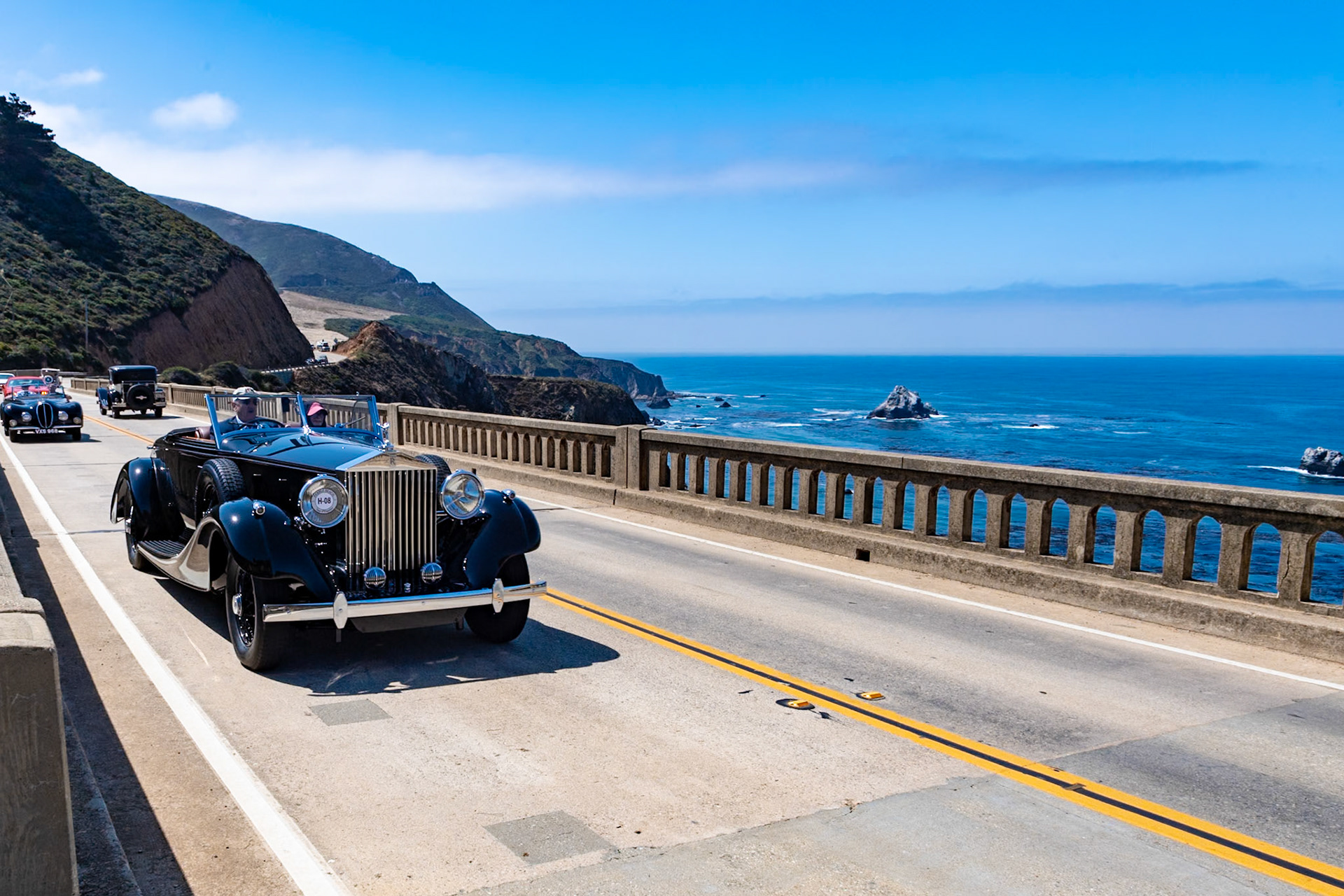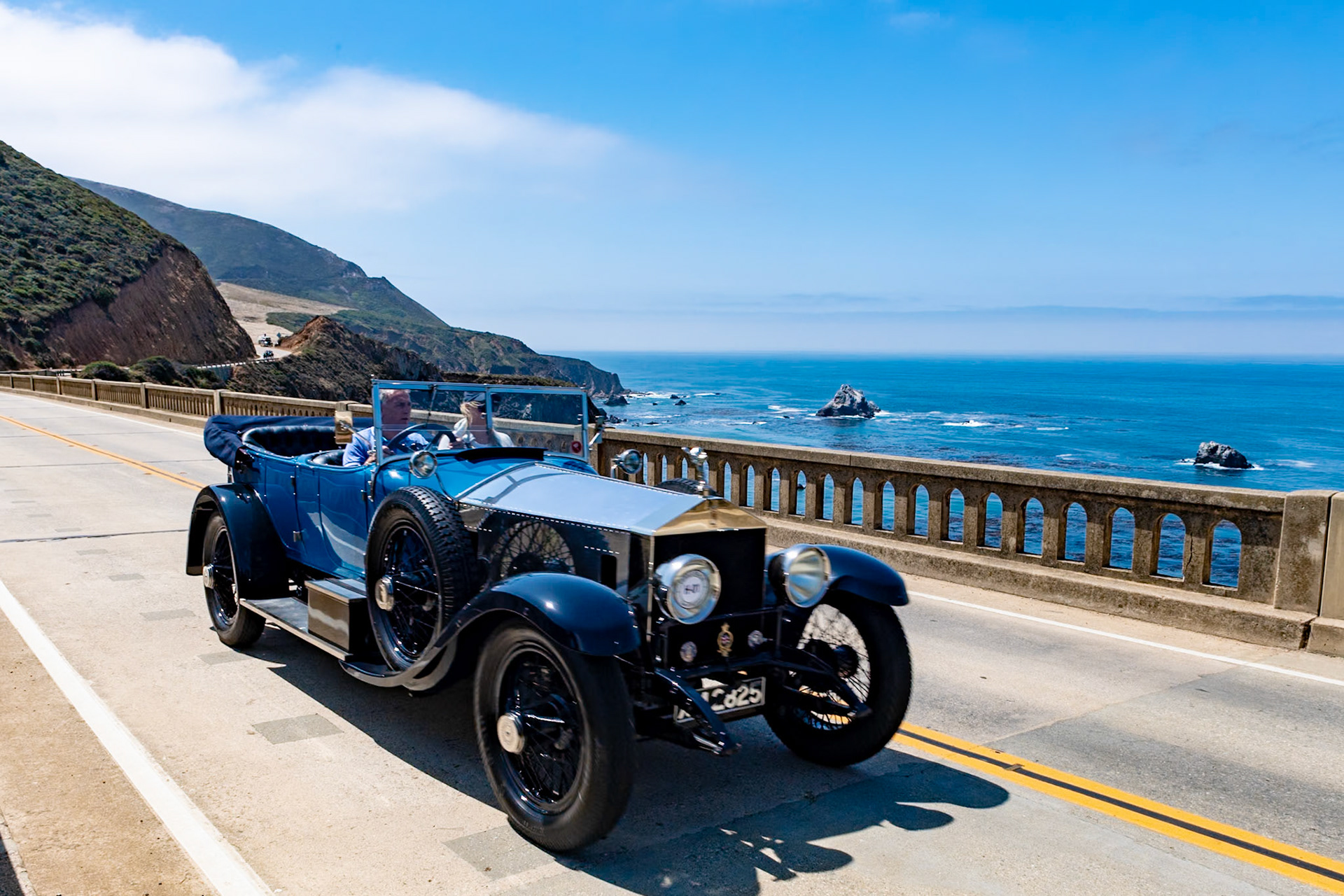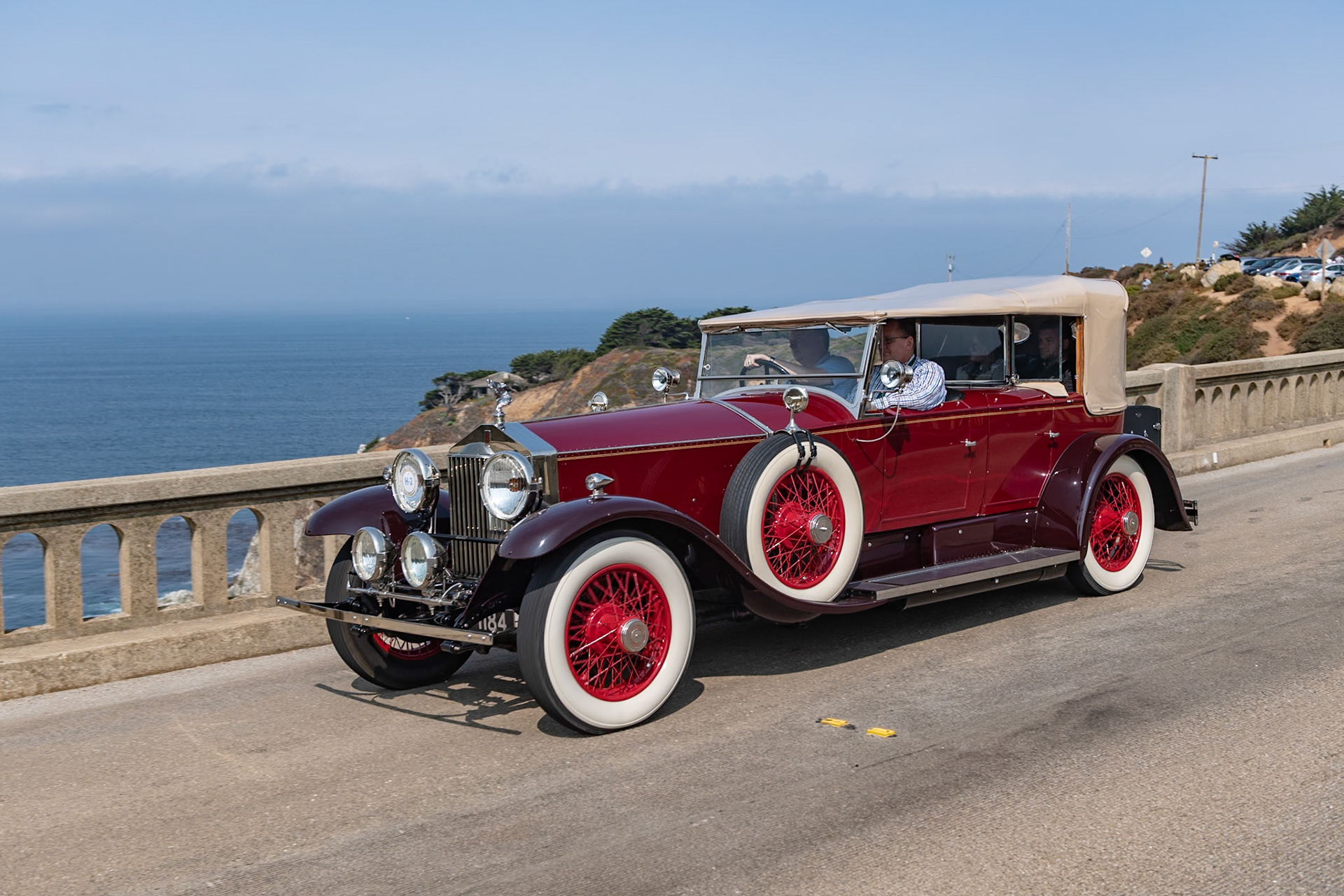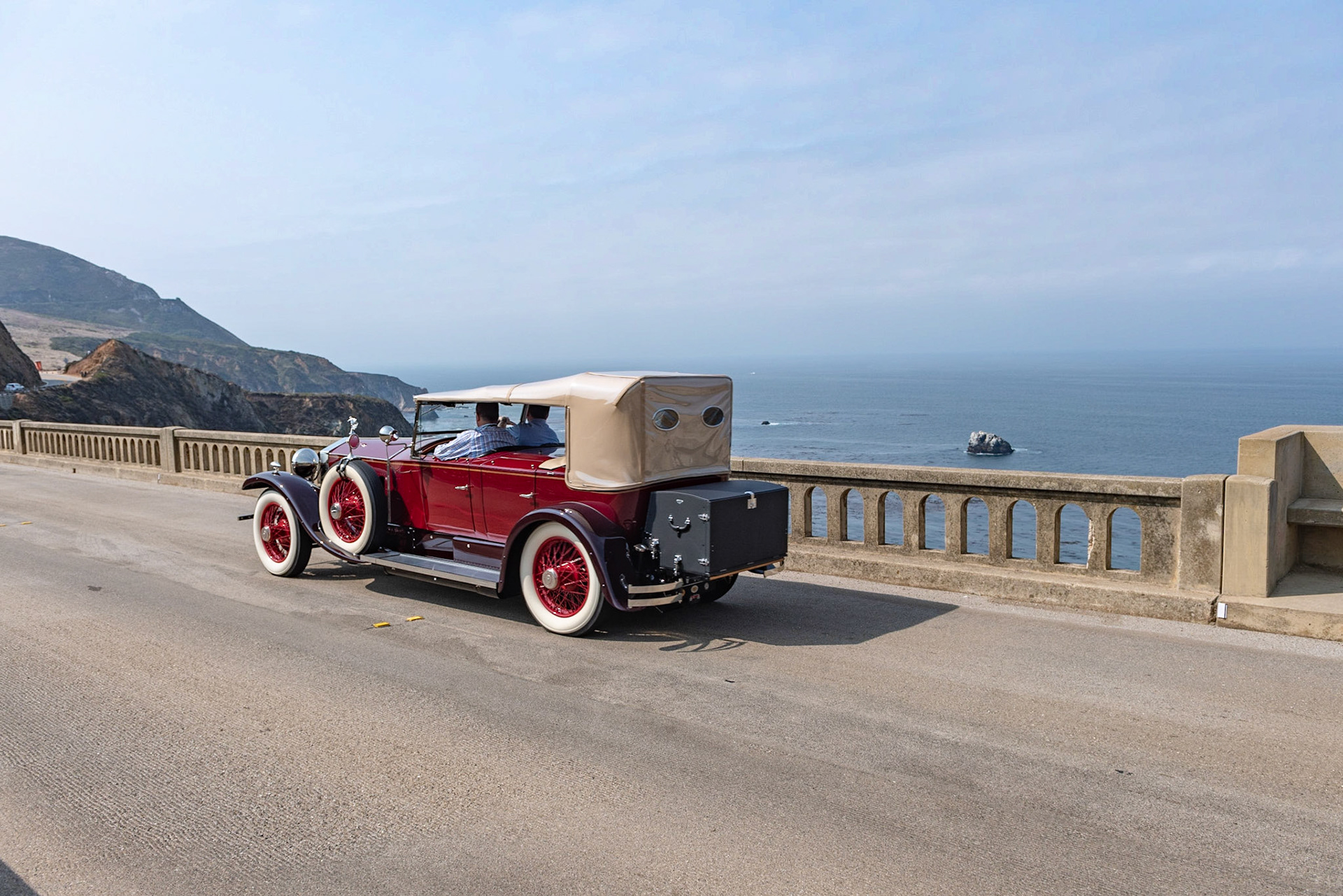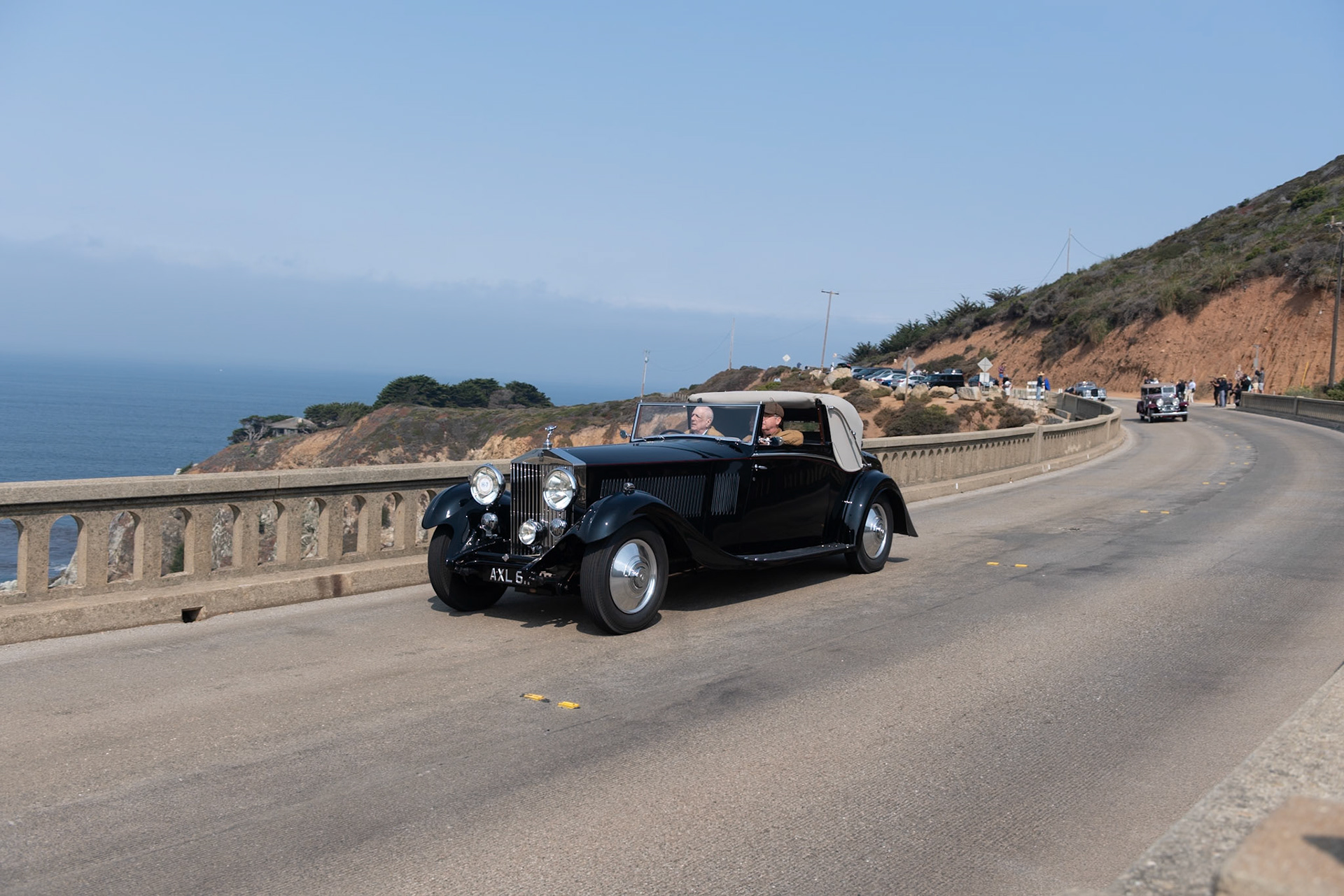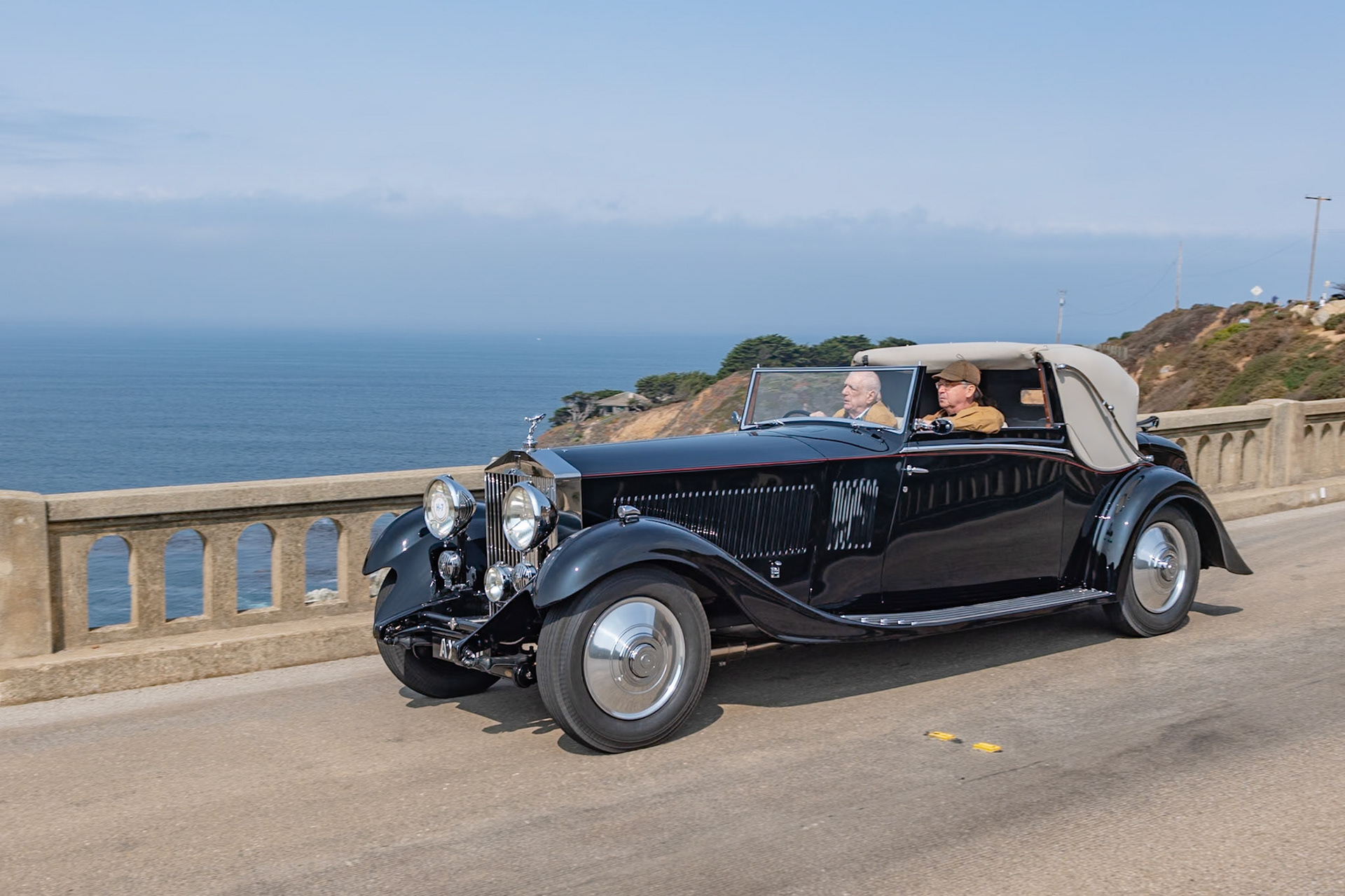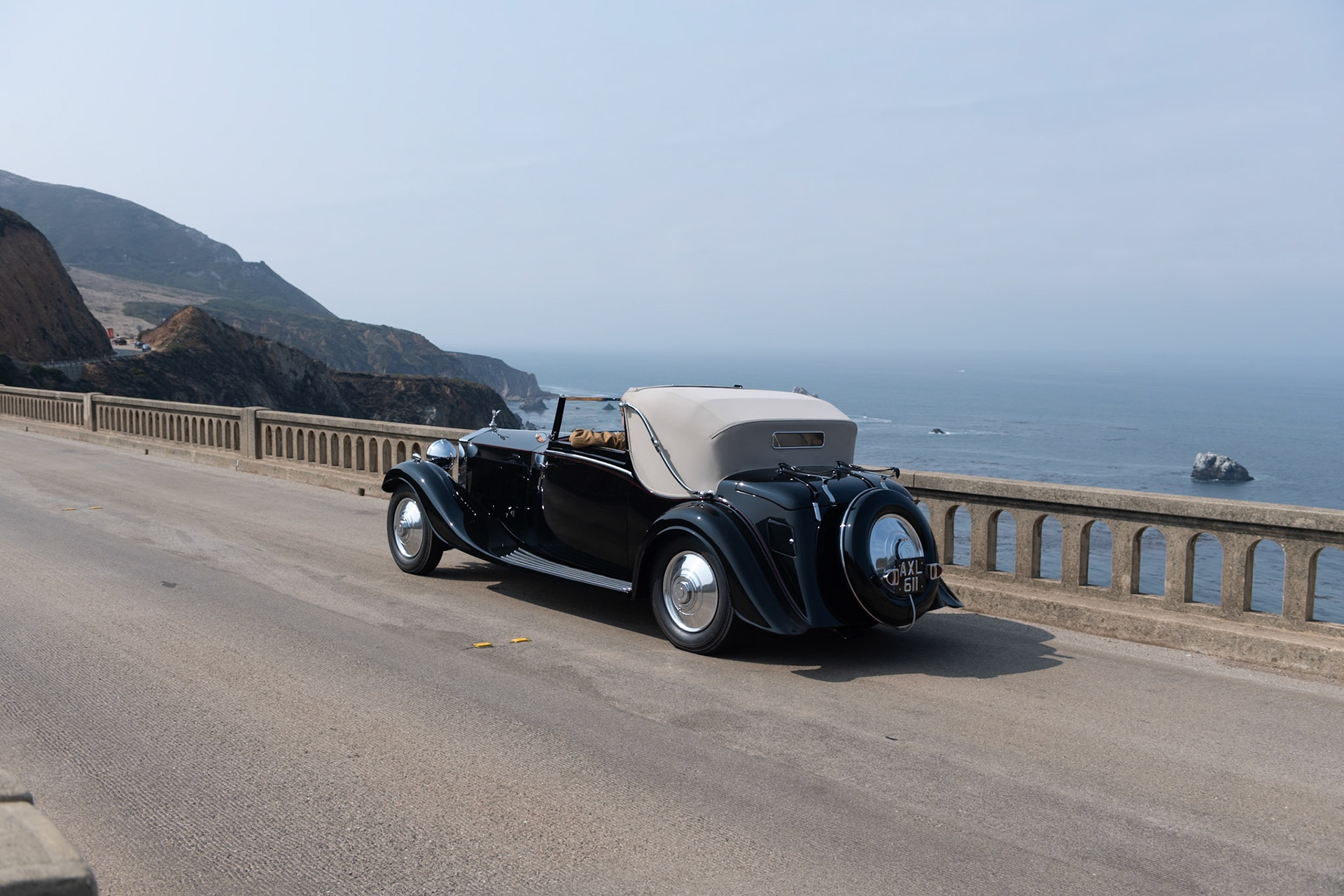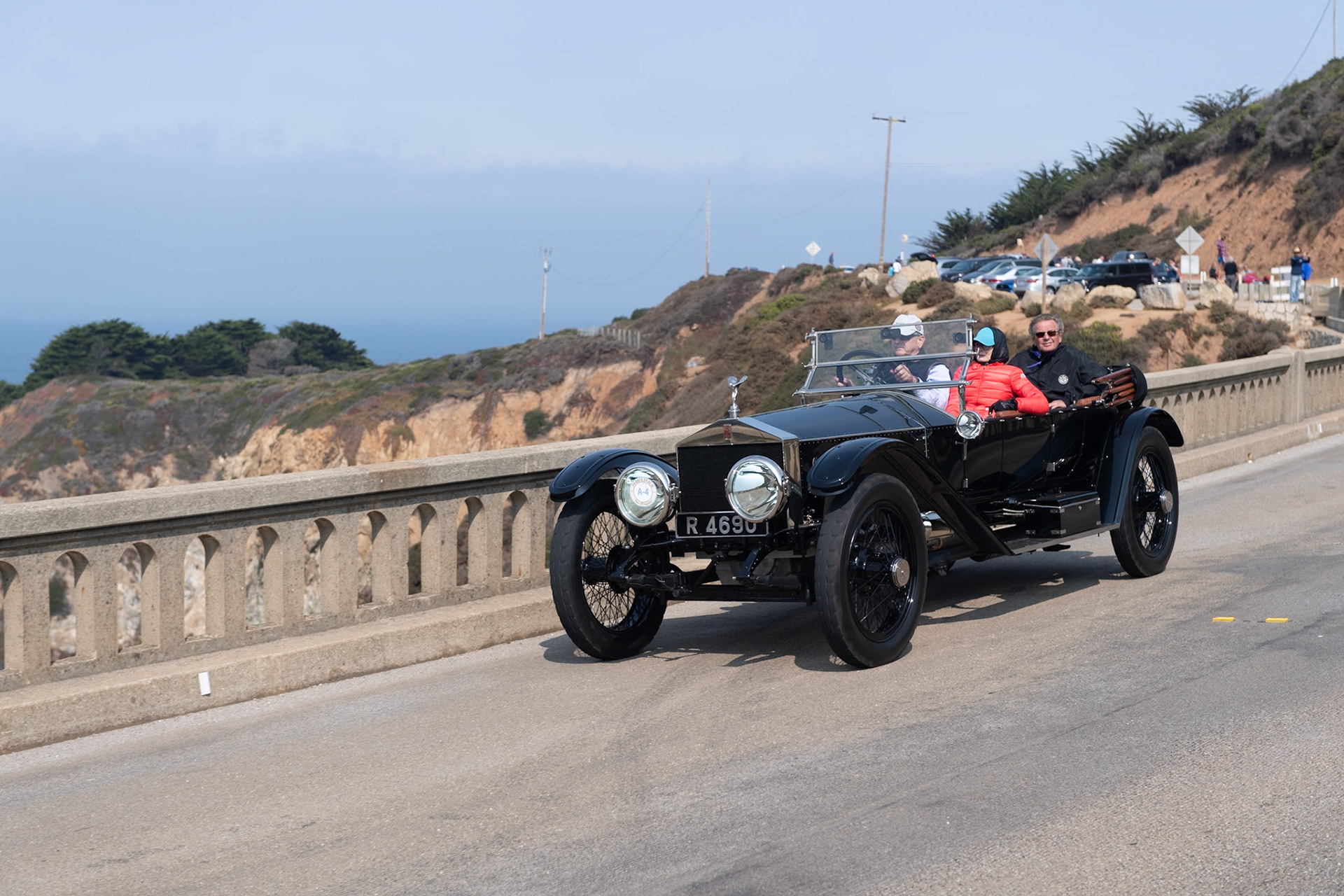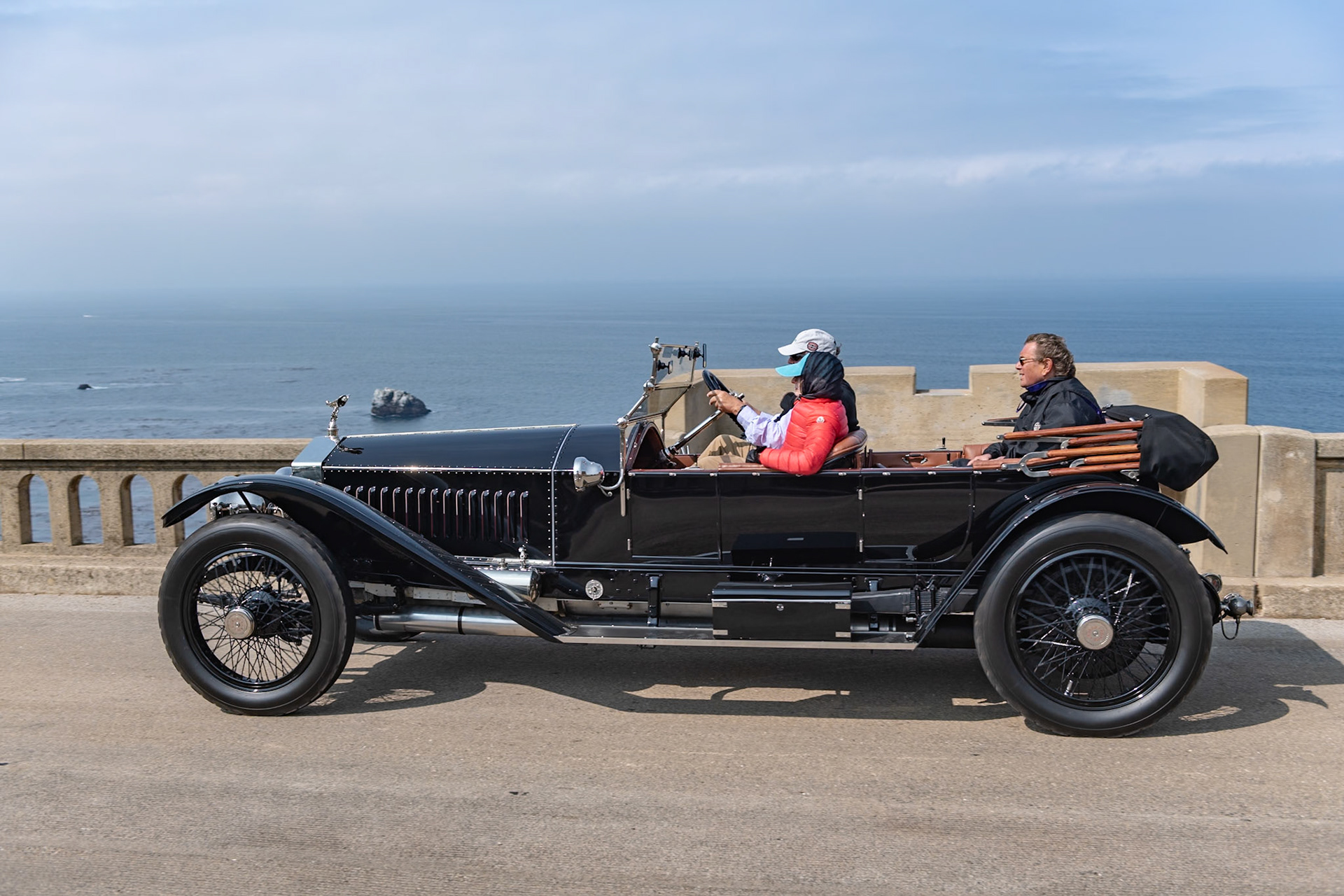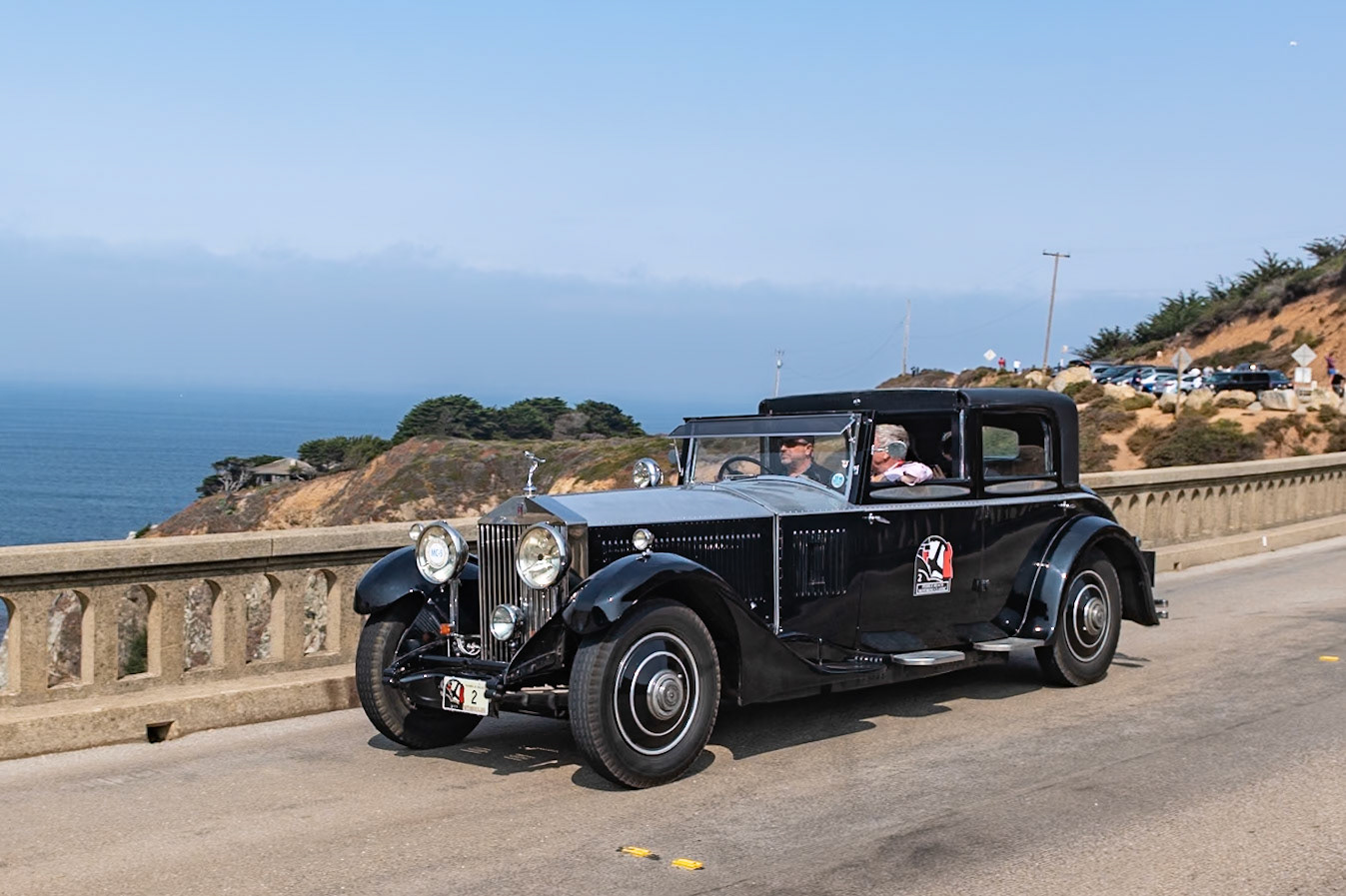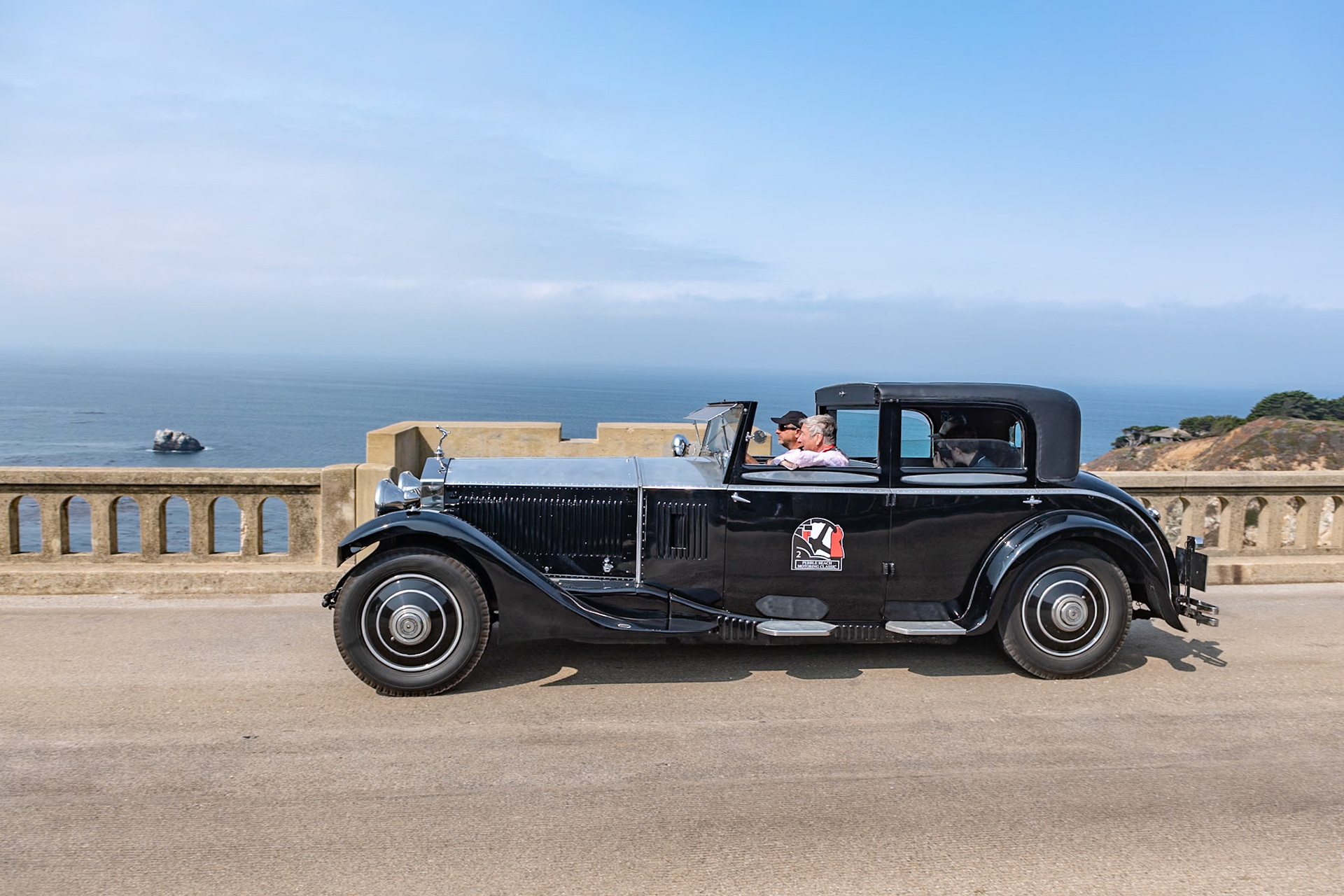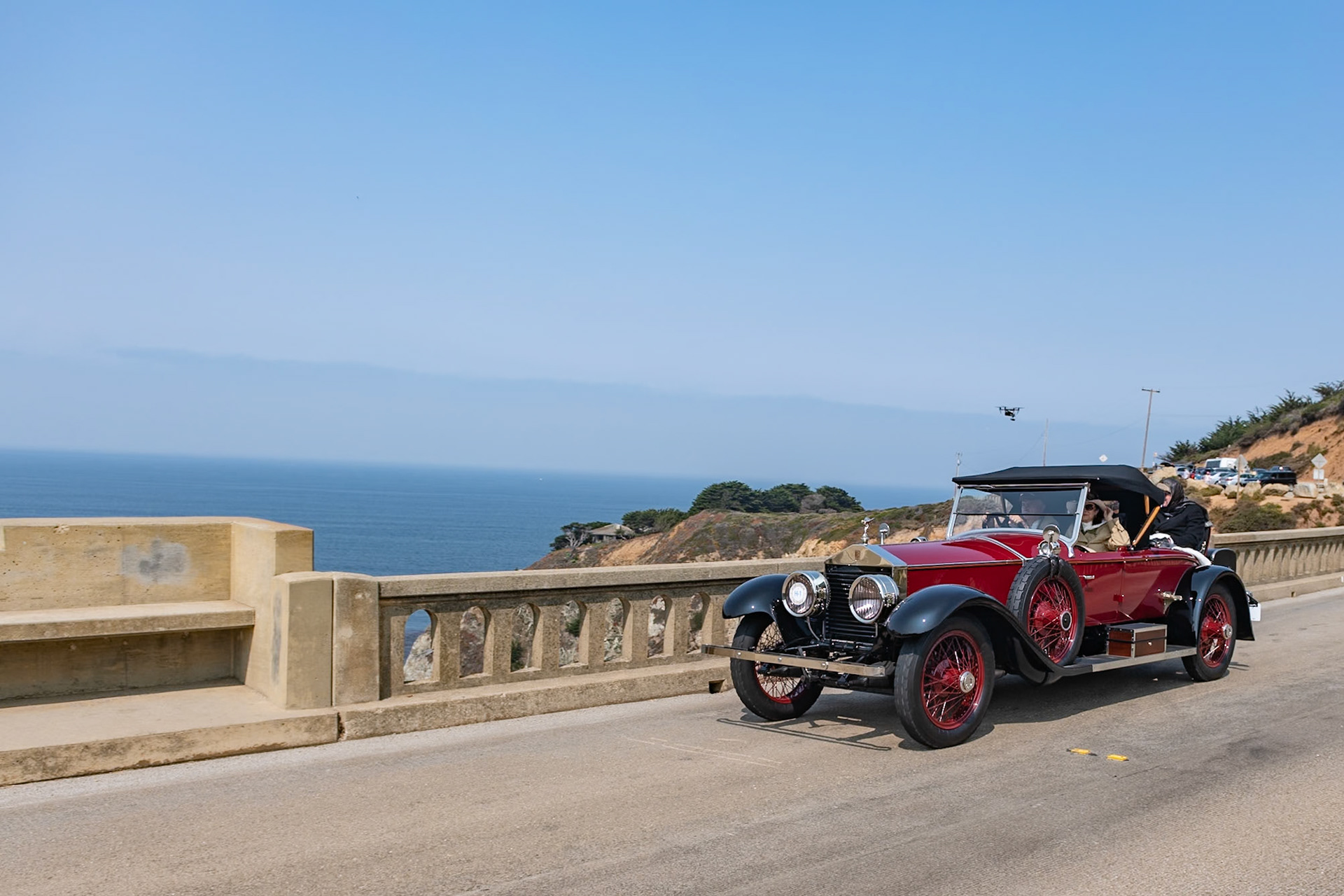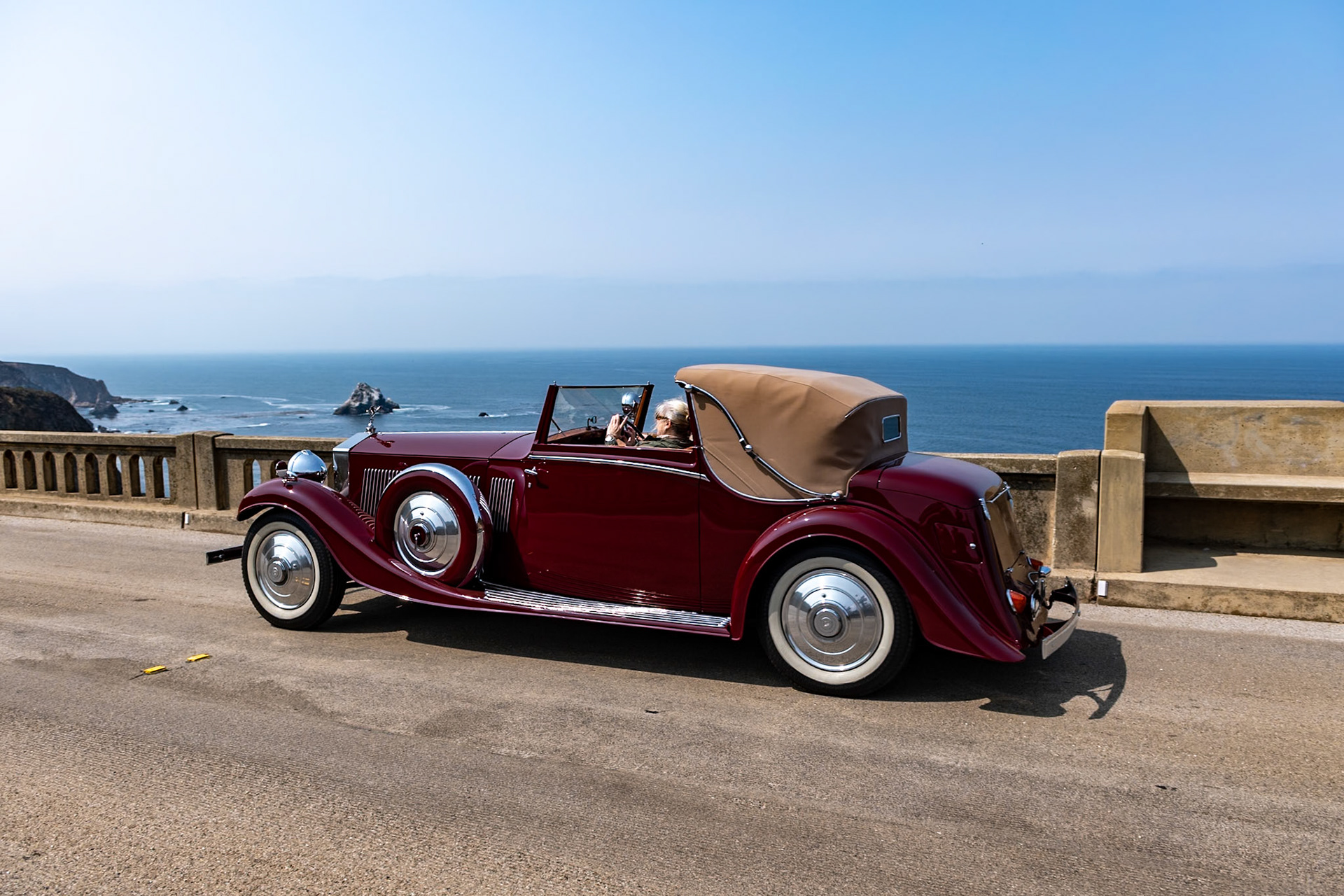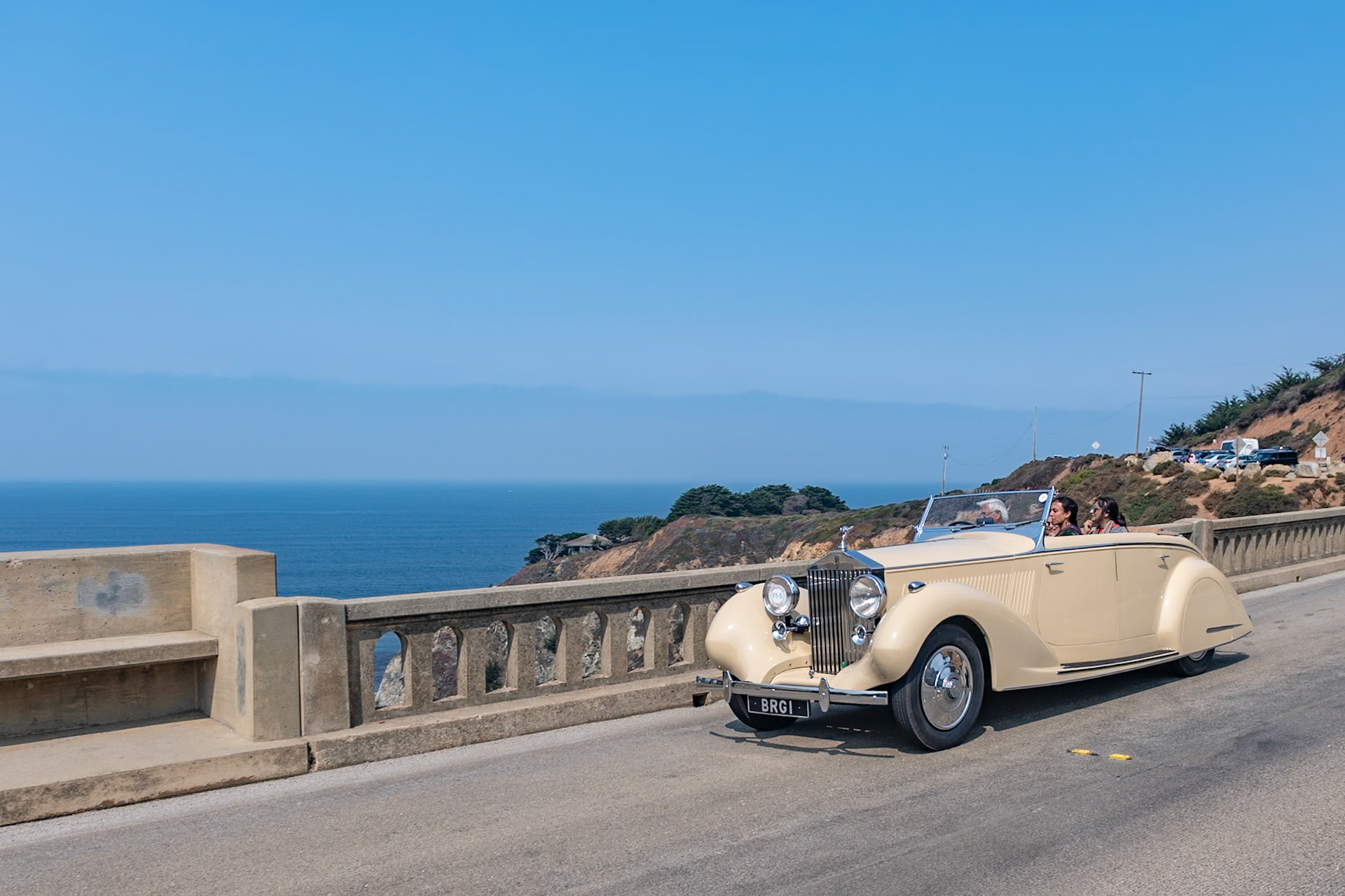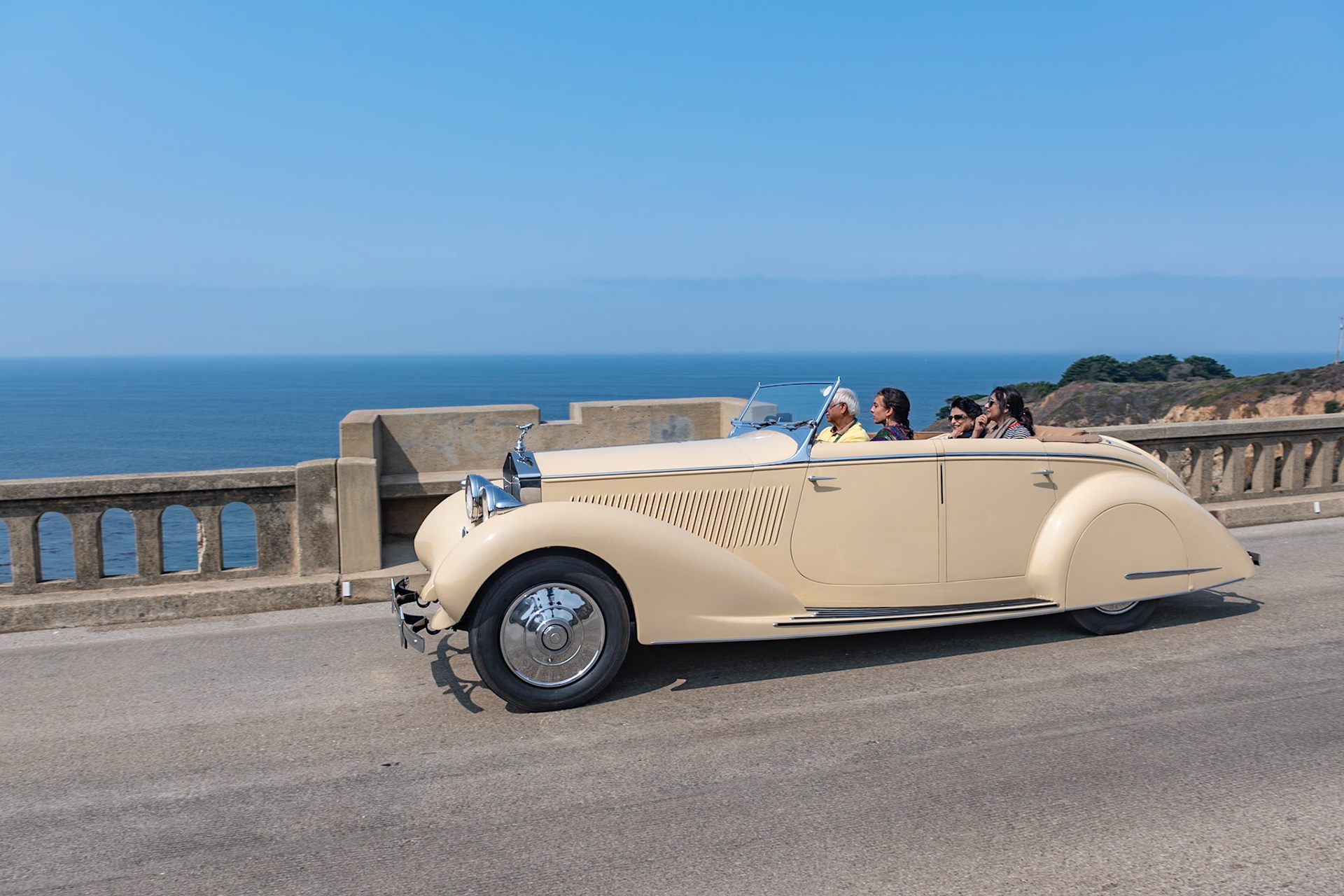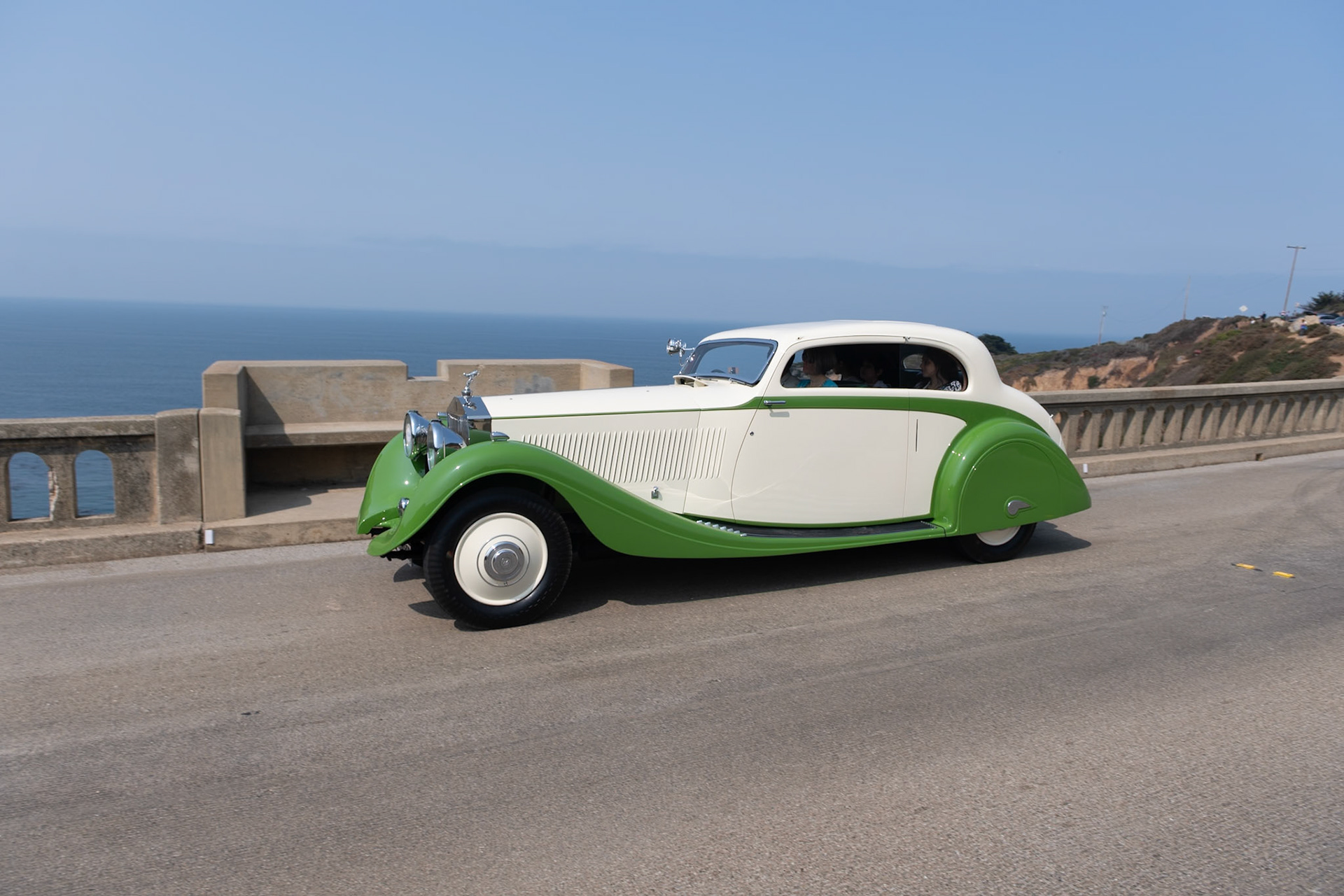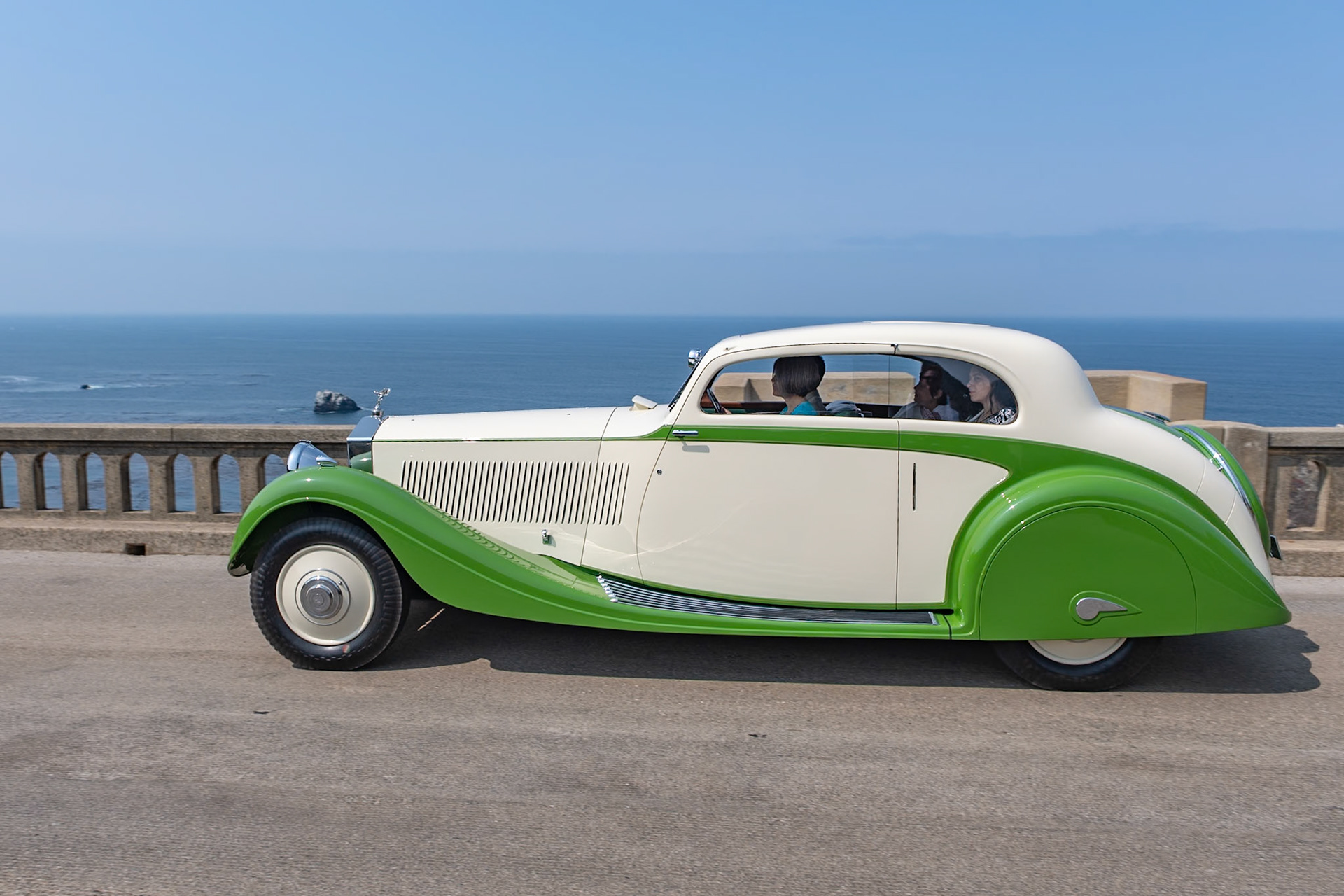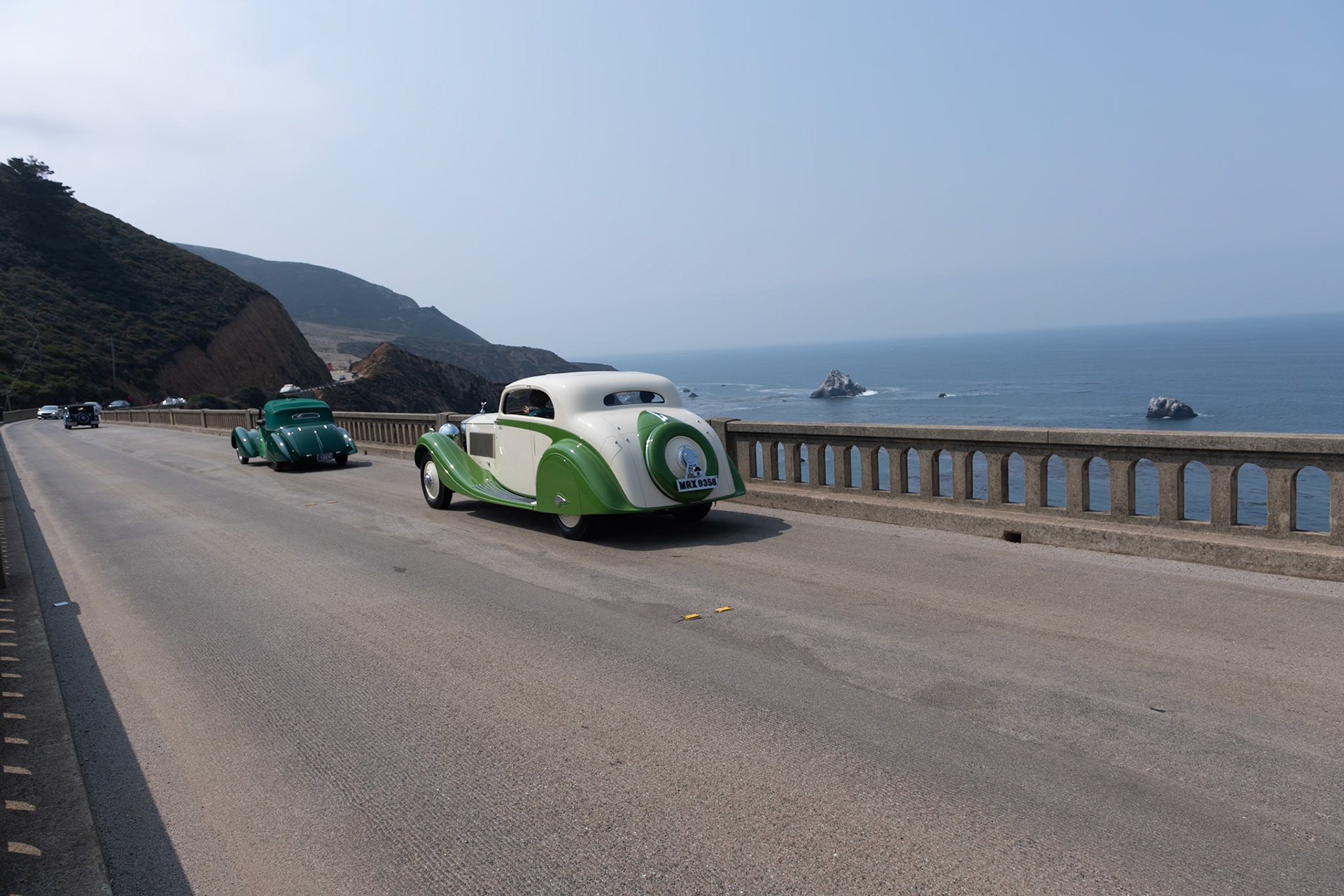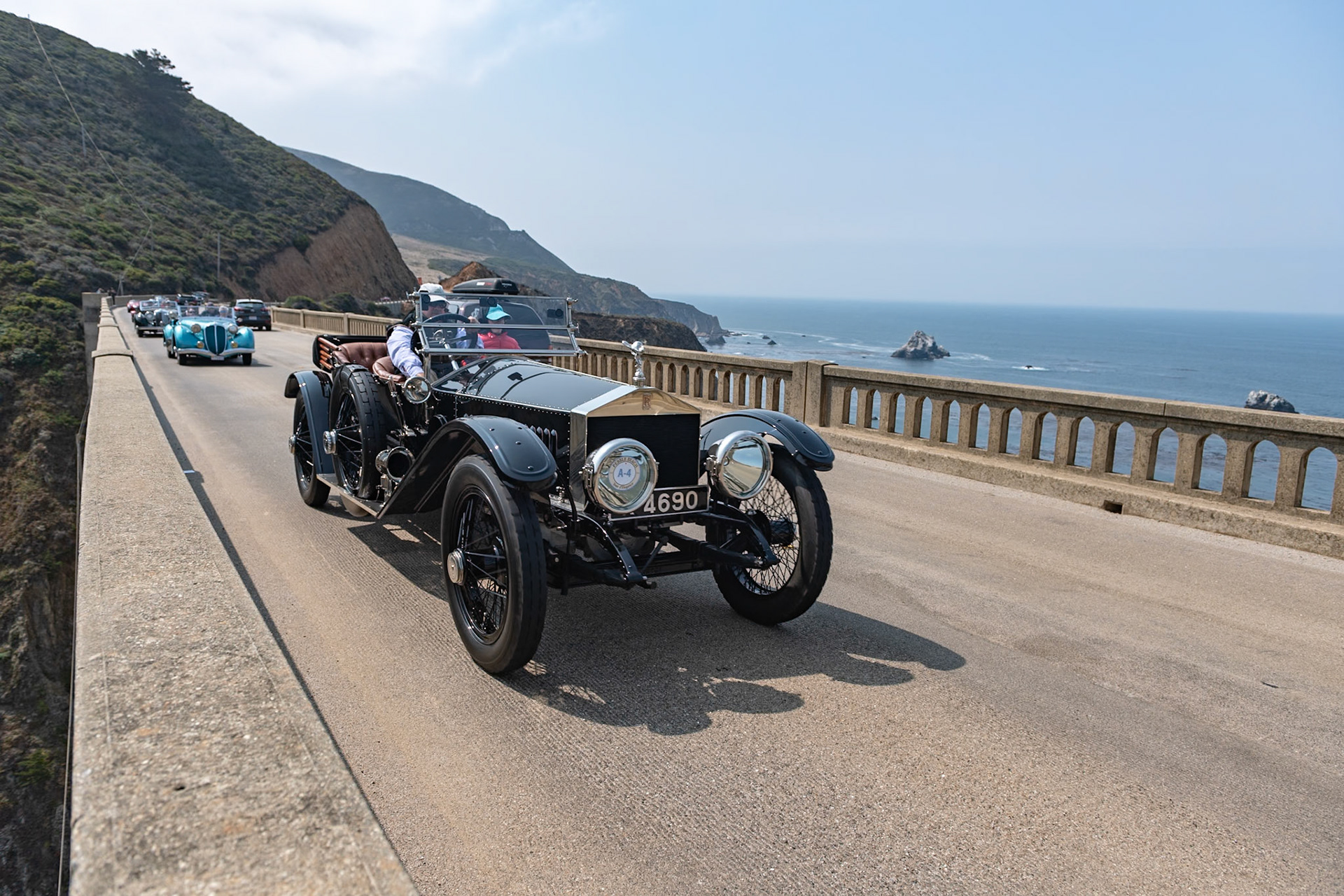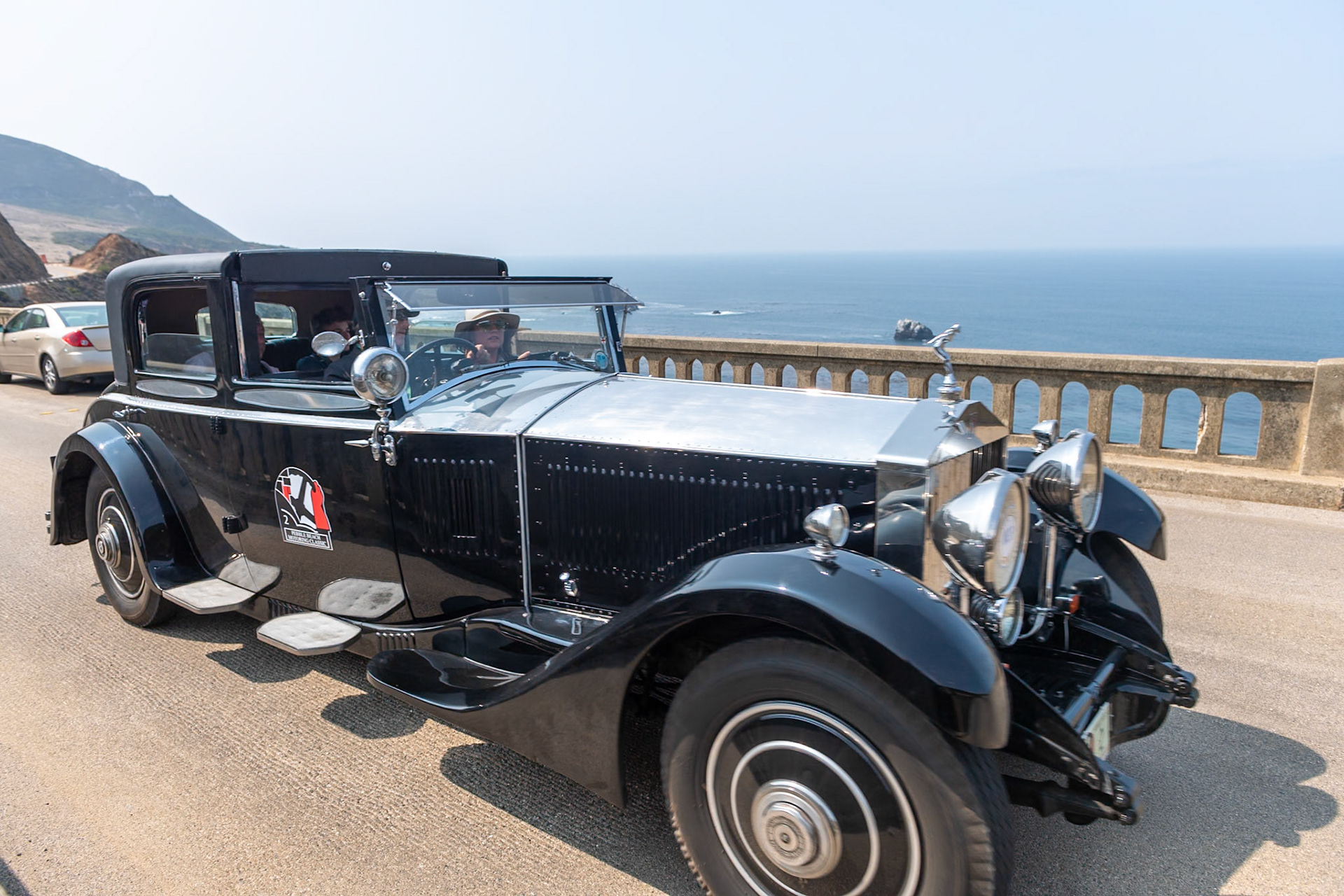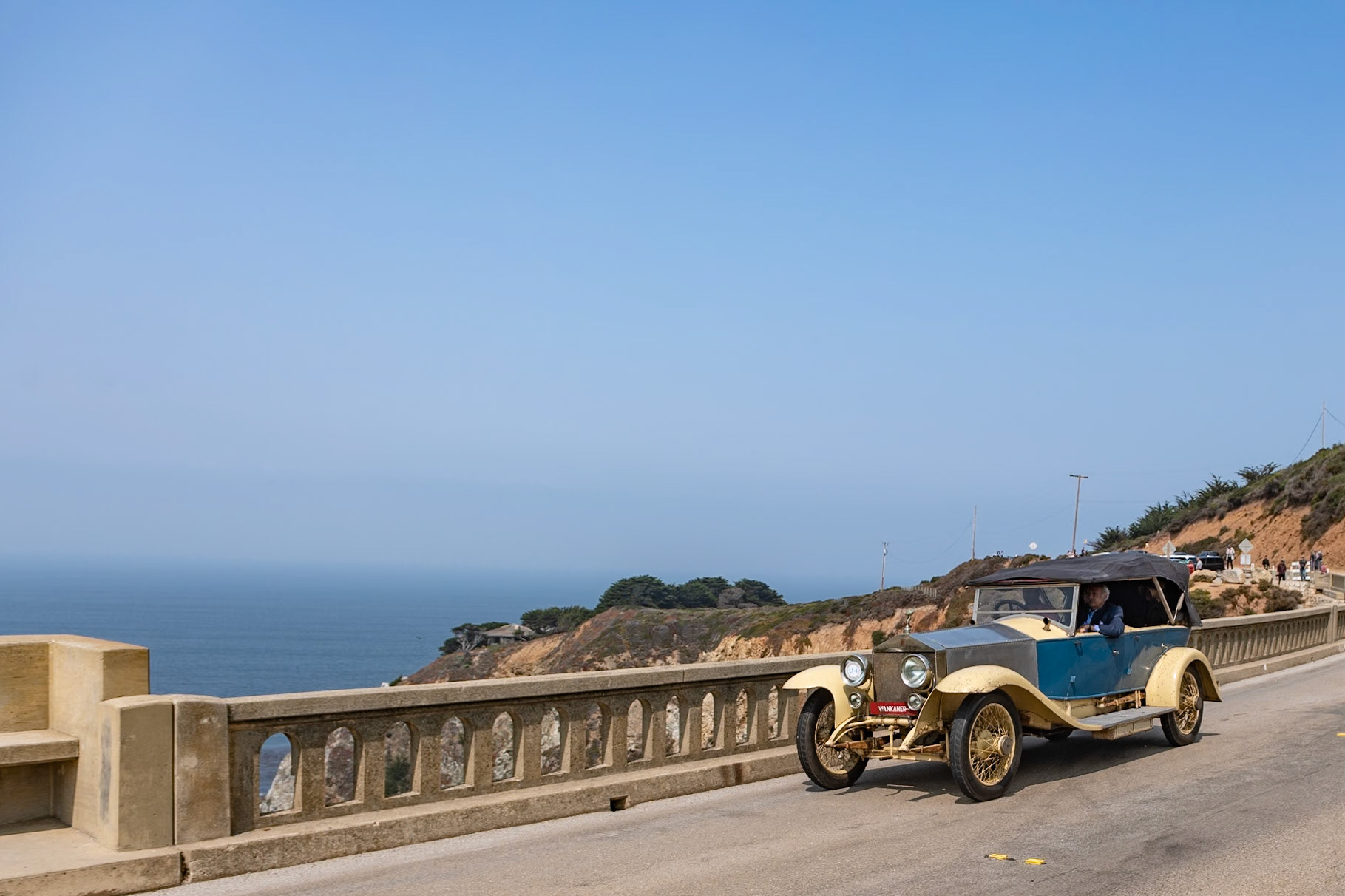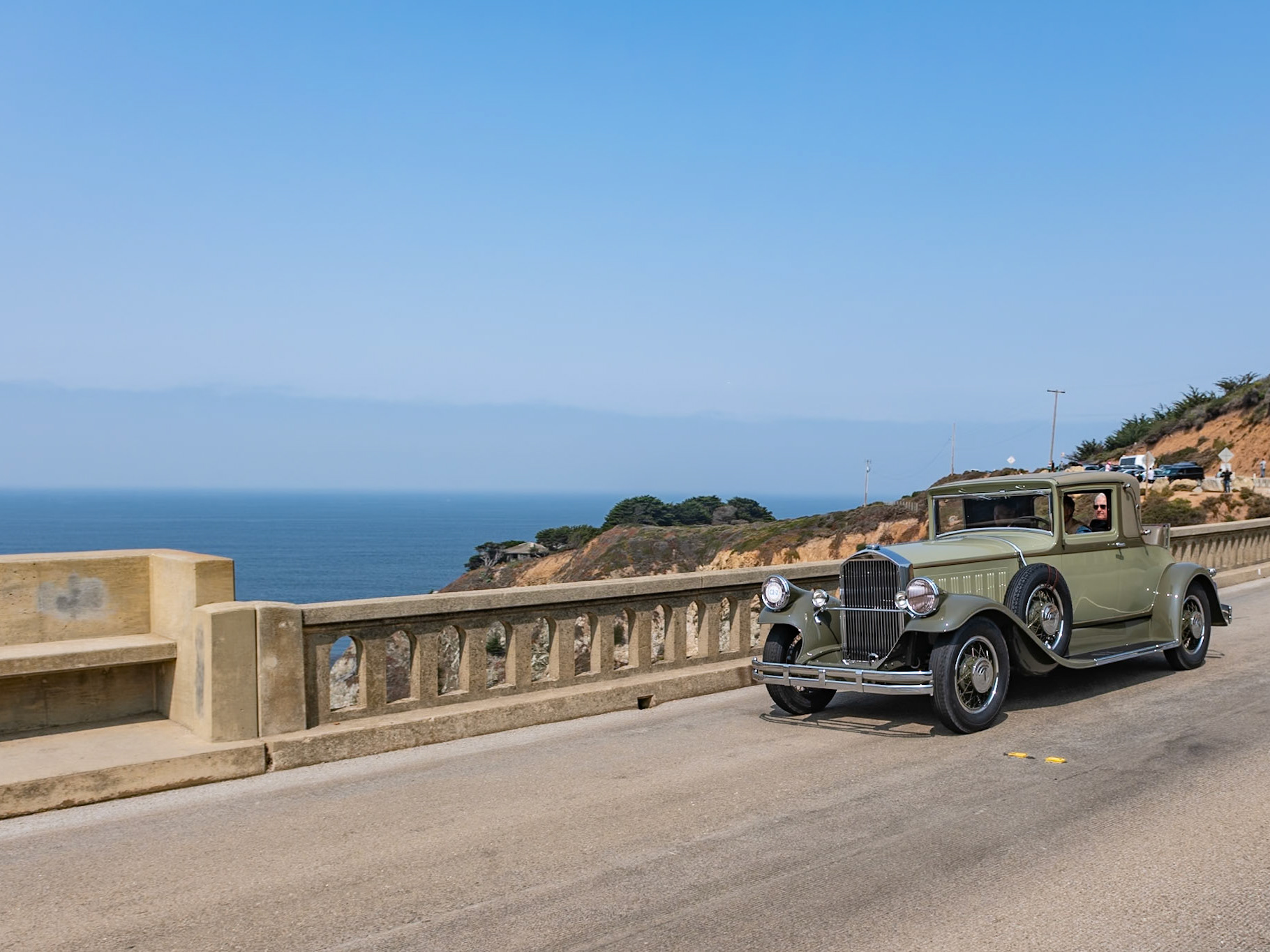
Bob & Gail Milhous, Paul and Mary Ann Milhous, Boca Raton, FL

This 1933 Rolls-Royce Phantom II (chassis 282 AJS) was ordered by Mrs. W. H. Luden of the Luden’s cough drop company. She already owned an Isotta Fraschini Tipo 8A with a Castagna Landaulet body, and she commissioned the Brewster Body Company to transfer that body to her new Rolls chassis. The result was this elegant Phantom II, combining Italian style with British engineering and American accents like the Brewster-style running boards. The interior features an ingenious illuminated system for notifying the chauffeur, using any of several languages, to turn left, turn right, speed up, slow down, turn around or go home. When purchased by the Atwell family in 1984, this unique Rolls-Royce had been completely dismantled. It was restored over the course of five years.

This Rolls-Royce Phantom I (chassis S317LR) was originally built in 1929 at the Springfield, Massachusetts, factory for a Mrs. J. Welz of Brooklyn, and it was first fitted with a formal Lonsdale-style limousine body by Brewster. Then, as was common in that era, rather than buying a new car a couple years later, Mrs. Welz had her Phantom re-bodied in 1932 with this Fleetwood-built convertible coupe originally designed for a V-16 Cadillac. At the same time the car was equipped with a Teleoptic rear indicator light and a Trilin combination rear light that are still with the car today. This thoroughly American Rolls-Royce has just been restored by its current owners after 15 years of happy ownership.

Rolls-Royce first began building automobiles for the American market in 1921 in Springfield, Massachusetts. After the acquisition of the Brewster Body Company in 1926 Rolls-Royce offered a selection of standard Brewster-built coachwork on its New Phantom (later called the Phantom I), which had been introduced that same year as the replacement for the Silver Ghost and offered a larger 7.7-liter engine. This car (chassis S203KR), built for Mr. R. E. Field of Milford, Ohio, had Ascot Sport Phaeton coachwork, a popular choice at the time. In all, some 350 Phantoms were built at the Springfield factory in 1929. This car’s current owner purchased it in 2013 and has restored it to its original configuration, complete with Buffalo Wire Wheels.

When Rolls-Royce unveiled the Phantom III at the 1935 Olympia Motor Show, it was the most technically advanced car in the world. Of the 727 Phantom IIIs built, fewer than 20 were bodied in the United States—all by the J.S Inskip company, which had acquired what was left of the Rolls-Royce Springfield, Massachusetts, factory and its subsidiary, Brewster, after they closed. This Phantom III (chassis 3CP18) features unique coachwork that resembles a Phantom II Henley but was referred to in Rolls-Royce records as a Convertible Roadster. Originally finished in black with leather upholstery, it was delivered to Colonel Joseph Samuels of Rhode Island, a wealthy philanthropist and founder of The Outlet Company. When the current owner acquired the motor car in 2009, it showed a mileage of 36,380, which is believed to be correct.

Bob and Gail Milhous, Paul & Mary Ann Milhous, Boca Raton, FL

This 1933 Rolls-Royce Phantom II (chassis 282 AJS) was ordered by Mrs. W. H. Luden of the Luden’s cough drop company. She already owned an Isotta Fraschini Tipo 8A with a Castagna Landaulet body, and she commissioned the Brewster Body Company to transfer that body to her new Rolls chassis. The result was this elegant Phantom II, combining Italian style with British engineering and American accents like the Brewster-style running boards. The interior features an ingenious illuminated system for notifying the chauffeur, using any of several languages, to turn left, turn right, speed up, slow down, turn around or go home. When purchased by the Atwell family in 1984, this unique Rolls-Royce had been completely dismantled. It was restored over the course of five years.

This famous Rolls-Royce Phantom III (chassis 3AX79) is known as “Monty’s Rolls” because it was owned for 20 years by Field Marshall Bernard Law Montgomery, First Viscount Montgomery of Alamein. The innovative coachwork was designed by the de Havilland Aircraft Company and built by H.J. Mulliner for use by the Chairman of de Havilland when touring in the United Kingdom and Europe. When tested in a wind tunnel, the forward-sloping Vee-windscreen was found to reduce wind resistance by about 15 percent. Early in the war the car was donated to the Army, and the car was frequently seen in newsreels transporting various dignitaries, including King George VI, President Dwight D. Eisenhower and Sir Winston Churchill. Monty retained the motor car, covering nearly 350,000 miles in it, until the death of his longtime chauffeur in 1962.

This 1913 Rolls-Royce Silver Ghost Torpedo was built on a London to Edinburgh 40/50 HP chassis (52 MA) for Mr. R. G. Reid, a native of St. John’s, Newfoundland, and a director of the Bank of Montreal in London. Barker Torpedo coachwork with a nickel finish was supplied, and the completed car was shipped to Canada where it remained for many years. This remarkable Silver Ghost survived with its original coachwork despite the intervention of the war when many Ghosts were rebuilt into armored cars. Joe Lorey of Cleveland restored the car, and it was subsequently driven over 100,000 miles, undertaking five transcontinental tours in the process. In 1999 it was bought by Don Meyer who also used it extensively, adding another 100,000 miles. It has recently been restored once again.

This Rolls-Royce Phantom I (chassis S317LR) was originally built in 1929 at the Springfield, Massachusetts, factory for a Mrs. J. Welz of Brooklyn, and it was first fitted with a formal Lonsdale-style limousine body by Brewster. Then, as was common in that era, rather than buying a new car a couple years later, Mrs. Welz had her Phantom re-bodied in 1932 with this Fleetwood-built convertible coupe originally designed for a V-16 Cadillac. At the same time the car was equipped with a Teleoptic rear indicator light and a Trilin combination rear light that are still with the car today. This thoroughly American Rolls-Royce has just been restored by its current owners after 15 years of happy ownership.

Rolls-Royce built the Silver Ghost chassis with a 6-cylinder, 7.5-liter 40/50 hp engine between 1907 and 1925. The famously silent engine, offering the ultimate driving experience, was a masterpiece of fine engineering; it had a hand-polished crankshaft lubricated by a pressurized oiling system with seven main bearings in a strong aluminum alloy crankcase as well as many other improvements, including phosphor-bronze and nickel steel timing gears. This Ghost (chassis 84TG) is fitted with a dual cowl touring body by Barker & Company of London. The lower-angled D-rake steering was specified for a more comfortable driving position, and a hinged Auster windscreen was fitted to protect the rear passengers. The Ghost was restored in 2008.

The Phantom II was the last model designed by Henry Royce in 1929. It had an entirely new low-slung chassis with its radiator set farther back, allowing coachbuilders to create much sleeker designs. It was available in two lengths, long for more formal cars and a shorter Continental version for more sporting cars. By the end of production the Phantom II Continental could achieve speeds of over 100 mph. This well-known example (chassis 4PY) was shown at the 1933 Paris Auto Salon before being delivered to its first owner, D. A. Sursock of Paris. In 1935 it was purchased by Britain’s Lord Faringdon, who owned the car until the 1960s. Soon after the purchase, the Phantom II was used by King George V at a review of a RAF squadron in Suffolk. Its current owner has enjoyed the car since 1984, driving it extensively on tours all over the United States.

The Rolls-Royce Phantom II was the third and last of the marque’s 40/50 hp models, replacing the New Phantom in 1929. This 1931 Rolls-Royce PII Continental Drophead Coupé (chassis 20MS) is one of just two Phantom IIs bodied by James Young. It is thought to have been built for Marion “Joe” Carstairs, who inherited a fortune from her mother. She had a passion for speed; she not only became a successful powerboat racer, she was also involved in helping Sir Malcolm Campbell and John Cobb establish world land speed records. This rare Rolls-Royce was later owned by another record holder and collector, Briggs Cunningham.

Rolls-Royce first began building automobiles for the American market in 1921 in Springfield, Massachusetts. After the acquisition of the Brewster Body Company in 1926 Rolls-Royce offered a selection of standard Brewster-built coachwork on its New Phantom (later called the Phantom I), which had been introduced that same year as the replacement for the Silver Ghost and offered a larger 7.7-liter engine. This car (chassis S203KR), built for Mr. R. E. Field of Milford, Ohio, had Ascot Sport Phaeton coachwork, a popular choice at the time. In all, some 350 Phantoms were built at the Springfield factory in 1929. This car’s current owner purchased it in 2013 and has restored it to its original configuration, complete with Buffalo Wire Wheels.

When Rolls-Royce unveiled the Phantom III at the 1935 Olympia Motor Show, it was the most technically advanced car in the world. Of the 727 Phantom IIIs built, fewer than 20 were bodied in the United States—all by the J.S Inskip company, which had acquired what was left of the Rolls-Royce Springfield, Massachusetts, factory and its subsidiary, Brewster, after they closed. This Phantom III (chassis 3CP18) features unique coachwork that resembles a Phantom II Henley but was referred to in Rolls-Royce records as a Convertible Roadster. Originally finished in black with leather upholstery, it was delivered to Colonel Joseph Samuels of Rhode Island, a wealthy philanthropist and founder of The Outlet Company. When the current owner acquired the motor car in 2009, it showed a mileage of 36,380, which is believed to be correct.

This famous Rolls-Royce Phantom III (chassis 3AX79) is known as “Monty’s Rolls” because it was owned for 20 years by Field Marshall Bernard Law Montgomery, First Viscount Montgomery of Alamein. The innovative coachwork was designed by the de Havilland Aircraft Company and built by H.J. Mulliner for use by the Chairman of de Havilland when touring in the United Kingdom and Europe. When tested in a wind tunnel, the forward-sloping Vee-windscreen was found to reduce wind resistance by about 15 percent. Early in the war the car was donated to the Army, and the car was frequently seen in newsreels transporting various dignitaries, including King George VI, President Dwight D. Eisenhower and Sir Winston Churchill. Monty retained the motor car, covering nearly 350,000 miles in it, until the death of his longtime chauffeur in 1962.

This 1913 Rolls-Royce Silver Ghost Torpedo was built on a London to Edinburgh 40/50 HP chassis (52 MA) for Mr. R. G. Reid, a native of St. John’s, Newfoundland, and a director of the Bank of Montreal in London. Barker Torpedo coachwork with a nickel finish was supplied, and the completed car was shipped to Canada where it remained for many years. This remarkable Silver Ghost survived with its original coachwork despite the intervention of the war when many Ghosts were rebuilt into armored cars. Joe Lorey of Cleveland restored the car, and it was subsequently driven over 100,000 miles, undertaking five transcontinental tours in the process. In 1999 it was bought by Don Meyer who also used it extensively, adding another 100,000 miles. It has recently been restored once again.

Rolls-Royce built the Silver Ghost chassis with a 6-cylinder, 7.5-liter 40/50 hp engine between 1907 and 1925. The famously silent engine, offering the ultimate driving experience, was a masterpiece of fine engineering; it had a hand-polished crankshaft lubricated by a pressurized oiling system with seven main bearings in a strong aluminum alloy crankcase as well as many other improvements, including phosphor-bronze and nickel steel timing gears. This Ghost (chassis 84TG) is fitted with a dual cowl touring body by Barker & Company of London. The lower-angled D-rake steering was specified for a more comfortable driving position, and a hinged Auster windscreen was fitted to protect the rear passengers. The Ghost was restored in 2008.

Rolls-Royce built the Silver Ghost chassis with a 6-cylinder, 7.5-liter 40/50 hp engine between 1907 and 1925. The famously silent engine, offering the ultimate driving experience, was a masterpiece of fine engineering; it had a hand-polished crankshaft lubricated by a pressurized oiling system with seven main bearings in a strong aluminum alloy crankcase as well as many other improvements, including phosphor-bronze and nickel steel timing gears. This Ghost (chassis 84TG) is fitted with a dual cowl touring body by Barker & Company of London. The lower-angled D-rake steering was specified for a more comfortable driving position, and a hinged Auster windscreen was fitted to protect the rear passengers. The Ghost was restored in 2008.

Known as “The Duchess,” this Phantom I Dual Cowl Torpedo Phaeton (chassis 43AL) was built in England and fitted with coachwork by Barker of London. The car boasts several upgrades, including cowl-mounted Zeiss spotlights and a trunk rack complete with a rare Brooks travel trunk. With the tall Auster windscreen to shield its rear passengers, the car was designed for continental touring for its first owner, Sir John Harmsworth, who owned the London Daily Mail newspaper and founded the Perrier Sparkling Water Co. His car was ordered as an exact replica of the Phantom I owned by Sir John’s brother, Lord Rothermere, that later appeared in the film Supergirl starring Faye Dunaway. Sir John owned the car for four years until his death in 1933, and then it passed through five different owners before being purchased by the current owner’s father in 1963. After restoring The Duchess, Irving Jensen Sr. showed it at the Pebble Beach Concours in 1976, when Irving Jr. was just 8 years old. The car is now in the hands of Irving Jensen III.

Known as “The Duchess,” this Phantom I Dual Cowl Torpedo Phaeton (chassis 43AL) was built in England and fitted with coachwork by Barker of London. The car boasts several upgrades, including cowl-mounted Zeiss spotlights and a trunk rack complete with a rare Brooks travel trunk. With the tall Auster windscreen to shield its rear passengers, the car was designed for continental touring for its first owner, Sir John Harmsworth, who owned the London Daily Mail newspaper and founded the Perrier Sparkling Water Co. His car was ordered as an exact replica of the Phantom I owned by Sir John’s brother, Lord Rothermere, that later appeared in the film Supergirl starring Faye Dunaway. Sir John owned the car for four years until his death in 1933, and then it passed through five different owners before being purchased by the current owner’s father in 1963. After restoring The Duchess, Irving Jensen Sr. showed it at the Pebble Beach Concours in 1976, when Irving Jr. was just 8 years old. The car is now in the hands of Irving Jensen III.

The Rolls-Royce Phantom II was the third and last of the Rolls-Royce 40/50 HP models, with an improved engine in an all-new and lower chassis. The engine was bolted directly to the 4-speed manual transmission, to which synchromesh was added after 1932. The Phantom II was designed with a 150-inch chassis, but a revised prototype was built on a 6-inch-shorter “Continental” chassis in 1930 and shown at the Biarritz Grand Concours d’Elegance, where it was awarded the Grand Prix d’Honneur. This car was the first of the PII Continental models, which proved popular with more adventurous drivers. This Phantom II (chassis 104PY) features a desirable 3-position Drophead Coupé body by H. J. Mulliner & Co. Ordered by its first owner for long trips to Europe, it came to the United States in 1958. Its current owner acquired the car in 2016 and commissioned a full restoration.

The Rolls-Royce Phantom II was the third and last of the Rolls-Royce 40/50 HP models, with an improved engine in an all-new and lower chassis. The engine was bolted directly to the 4-speed manual transmission, to which synchromesh was added after 1932. The Phantom II was designed with a 150-inch chassis, but a revised prototype was built on a 6-inch-shorter “Continental” chassis in 1930 and shown at the Biarritz Grand Concours d’Elegance, where it was awarded the Grand Prix d’Honneur. This car was the first of the PII Continental models, which proved popular with more adventurous drivers. This Phantom II (chassis 104PY) features a desirable 3-position Drophead Coupé body by H. J. Mulliner & Co. Ordered by its first owner for long trips to Europe, it came to the United States in 1958. Its current owner acquired the car in 2016 and commissioned a full restoration.

The Rolls-Royce Phantom II was the third and last of the Rolls-Royce 40/50 HP models, with an improved engine in an all-new and lower chassis. The engine was bolted directly to the 4-speed manual transmission, to which synchromesh was added after 1932. The Phantom II was designed with a 150-inch chassis, but a revised prototype was built on a 6-inch-shorter “Continental” chassis in 1930 and shown at the Biarritz Grand Concours d’Elegance, where it was awarded the Grand Prix d’Honneur. This car was the first of the PII Continental models, which proved popular with more adventurous drivers. This Phantom II (chassis 104PY) features a desirable 3-position Drophead Coupé body by H. J. Mulliner & Co. Ordered by its first owner for long trips to Europe, it came to the United States in 1958. Its current owner acquired the car in 2016 and commissioned a full restoration.

Rolls-Royce introduced the 40/50 HP model, later called the Silver Ghost, in 1907. In 1911, one of its main rivals, Napier, challenged Rolls-Royce to an endurance trial driving from London to Edinburgh, a distance of over 800 miles on largely unpaved roads. A Silver Ghost Holmes Tourer won the contest, establishing the model’s reputation as “the best car in the world.” Rolls-Royce subsequently introduced its sporty London to Edinburgh chassis with underslung, semi-elliptical rear springs allowing its body to rest much lower. Lightweight coachwork was usually specified for these chassis. This particular Silver Ghost (chassis 2015), the twenty-second built to this specification, was first delivered to the Marquis de Linares in Paris. It was later sold to a Spanish owner and its original body was lost. Today the car has been fully restored in its original style.

Rolls-Royce introduced the 40/50 HP model, later called the Silver Ghost, in 1907. In 1911, one of its main rivals, Napier, challenged Rolls-Royce to an endurance trial driving from London to Edinburgh, a distance of over 800 miles on largely unpaved roads. A Silver Ghost Holmes Tourer won the contest, establishing the model’s reputation as “the best car in the world.” Rolls-Royce subsequently introduced its sporty London to Edinburgh chassis with underslung, semi-elliptical rear springs allowing its body to rest much lower. Lightweight coachwork was usually specified for these chassis. This particular Silver Ghost (chassis 2015), the twenty-second built to this specification, was first delivered to the Marquis de Linares in Paris. It was later sold to a Spanish owner and its original body was lost. Today the car has been fully restored in its original style.

1930 Rolls-Royce P-II Sedanca deVille, Windovers Roland Duce & Kimberly HughsonJames DuceThurgarton, Notts, UK

1930 Rolls-Royce P-II Sedanca deVille, Windovers Roland Duce & Kimberly HughsonJames DuceThurgarton, Notts, UK

1930 Rolls-Royce P-II Sedanca deVille, Windovers Roland Duce & Kimberly HughsonJames DuceThurgarton, Notts, UK

The new top-of-the-range Rolls-Royce Phantom V, introduced in autumn of 1959, replaced both the Phantom IV and the Silver Wraith. It had a new 6,230 cc all-alloy V8 engine that was also used in Silver Cloud II and Bentley S2 saloons, and it was built on a modified and strengthened Rolls-Royce Silver Cloud II 145-inch wheelbase chassis. With suitably luxurious coachwork, the finished cars measured well over 20 feet in length. Despite its size, the Phantom V was still quite capable of exceeding 100 mph. Many of the first orders came from the royal families of Europe and other dignitaries, but the bulk of inquiries came from industry or private individuals. Over the course of its 9-year production run, 516 Phantom Vs were sold, and most were built in England. This striking Limousine is an exception, boasting what is possibly Henri Chapron’s largest-ever body, designed for Mrs. K. Millbank of Paris. It first appeared at the 1961 Paris Auto Salon and has just been restored to its appearance there, with the deep green paintwork and pale green interior.

The new top-of-the-range Rolls-Royce Phantom V, introduced in autumn of 1959, replaced both the Phantom IV and the Silver Wraith. It had a new 6,230 cc all-alloy V8 engine that was also used in Silver Cloud II and Bentley S2 saloons, and it was built on a modified and strengthened Rolls-Royce Silver Cloud II 145-inch wheelbase chassis. With suitably luxurious coachwork, the finished cars measured well over 20 feet in length. Despite its size, the Phantom V was still quite capable of exceeding 100 mph. Many of the first orders came from the royal families of Europe and other dignitaries, but the bulk of inquiries came from industry or private individuals. Over the course of its 9-year production run, 516 Phantom Vs were sold, and most were built in England. This striking Limousine is an exception, boasting what is possibly Henri Chapron’s largest-ever body, designed for Mrs. K. Millbank of Paris. It first appeared at the 1961 Paris Auto Salon and has just been restored to its appearance there, with the deep green paintwork and pale green interior.

This Springfield-built Rolls-Royce 40/50 HP Silver Ghost, has a lightweight and sporty Piccadilly roadster body built for Rolls-Royce Custom Coachworks (RRCC) by the Merrimac Body Co., a subsidiary of the J. B. Judkins coachworks in Massachusetts. Merrimac built most of the open roadster and touring bodies for the Springfield factory—on both the Silver Ghost as well as the New Phantom chassis. This Piccadilly roadster (chassis 318XH) is one of 79 Ghosts bodied in this style. It was ordered by E. D. Gaither of Cincinnati, Ohio, in July 1923. In the 1950s it was owned by the collector Richard C. Paine Jr. and shown at his Seal Cove Automobile Museum. After several changes of ownership, the current owner purchased it earlier this year.

This Springfield-built Rolls-Royce 40/50 HP Silver Ghost, has a lightweight and sporty Piccadilly roadster body built for Rolls-Royce Custom Coachworks (RRCC) by the Merrimac Body Co., a subsidiary of the J. B. Judkins coachworks in Massachusetts. Merrimac built most of the open roadster and touring bodies for the Springfield factory—on both the Silver Ghost as well as the New Phantom chassis. This Piccadilly roadster (chassis 318XH) is one of 79 Ghosts bodied in this style. It was ordered by E. D. Gaither of Cincinnati, Ohio, in July 1923. In the 1950s it was owned by the collector Richard C. Paine Jr. and shown at his Seal Cove Automobile Museum. After several changes of ownership, the current owner purchased it earlier this year.

The much-improved Rolls-Royce Phantom II was introduced in September 1929, replacing the outdated New Phantom. Between 1929 and 1935, 1,672 Phantom IIs were built, including 280 on the stronger and shorter 144-inch Continental chassis, built to carry four people in comfort at high speeds. To balance the heavy chassis, lightweight coachwork was often fitted on it; the majority of Phantom IIs had 4-door closed coachwork, but a small number were fitted with more stylish designs, such as this Drophead Sedanca Coupé built by H. J. Mulliner in London. Described by Mulliner as a sportsman’s coupé, this is one of five similar PII Continentals built to be as lightweight as possible; they even included a special Exonite cellulose–covered aluminum steering wheel designed for aircraft. This Phantom II (chassis 55RY) was originally purchased by John “Jack” Upson, the owner of the famous Monseigneur Restaurant in Piccadilly and the chairman of the Dolcis shoe empire. It was acquired by its current owner in 1987.

The much-improved Rolls-Royce Phantom II was introduced in September 1929, replacing the outdated New Phantom. Between 1929 and 1935, 1,672 Phantom IIs were built, including 280 on the stronger and shorter 144-inch Continental chassis, built to carry four people in comfort at high speeds. To balance the heavy chassis, lightweight coachwork was often fitted on it; the majority of Phantom IIs had 4-door closed coachwork, but a small number were fitted with more stylish designs, such as this Drophead Sedanca Coupé built by H. J. Mulliner in London. Described by Mulliner as a sportsman’s coupé, this is one of five similar PII Continentals built to be as lightweight as possible; they even included a special Exonite cellulose–covered aluminum steering wheel designed for aircraft. This Phantom II (chassis 55RY) was originally purchased by John “Jack” Upson, the owner of the famous Monseigneur Restaurant in Piccadilly and the chairman of the Dolcis shoe empire. It was acquired by its current owner in 1987.

The much-improved Rolls-Royce Phantom II was introduced in September 1929, replacing the outdated New Phantom. Between 1929 and 1935, 1,672 Phantom IIs were built, including 280 on the stronger and shorter 144-inch Continental chassis, built to carry four people in comfort at high speeds. To balance the heavy chassis, lightweight coachwork was often fitted on it; the majority of Phantom IIs had 4-door closed coachwork, but a small number were fitted with more stylish designs, such as this Drophead Sedanca Coupé built by H. J. Mulliner in London. Described by Mulliner as a sportsman’s coupé, this is one of five similar PII Continentals built to be as lightweight as possible; they even included a special Exonite cellulose–covered aluminum steering wheel designed for aircraft. This Phantom II (chassis 55RY) was originally purchased by John “Jack” Upson, the owner of the famous Monseigneur Restaurant in Piccadilly and the chairman of the Dolcis shoe empire. It was acquired by its current owner in 1987.

This Rolls-Royce 25/30 HP All Weather Tourer (chassis GRO48) was bodied by Gurney Nutting and supplied to the Maharajah of Darbhanga. The 25/30 HP was an entry-level Rolls-Royce with an enlarged 6-cylinder engine developed from the Rolls-Royce 20/25 HP—the same engine used in the more sporty Bentley 4¼ Litre. The car was also equipped with servo-assisted brakes built under license from Hispano-Suiza. This Rolls-Royce 25/30 HP with its 4-door, all weather, disappearing-top body, is one of three identical cars shipped to India before the war—and all three survive today. This actual car was the model used by Rolls-Royce in its Indian newspaper advertisements. It was bought by its current owner in 1973 and restored in England 20 years later. This the first time the car has been seen at Pebble Beach.

This Rolls-Royce 25/30 HP All Weather Tourer (chassis GRO48) was bodied by Gurney Nutting and supplied to the Maharajah of Darbhanga. The 25/30 HP was an entry-level Rolls-Royce with an enlarged 6-cylinder engine developed from the Rolls-Royce 20/25 HP—the same engine used in the more sporty Bentley 4¼ Litre. The car was also equipped with servo-assisted brakes built under license from Hispano-Suiza. This Rolls-Royce 25/30 HP with its 4-door, all weather, disappearing-top body, is one of three identical cars shipped to India before the war—and all three survive today. This actual car was the model used by Rolls-Royce in its Indian newspaper advertisements. It was bought by its current owner in 1973 and restored in England 20 years later. This the first time the car has been seen at Pebble Beach.

This Rolls-Royce 25/30 HP All Weather Tourer (chassis GRO48) was bodied by Gurney Nutting and supplied to the Maharajah of Darbhanga. The 25/30 HP was an entry-level Rolls-Royce with an enlarged 6-cylinder engine developed from the Rolls-Royce 20/25 HP—the same engine used in the more sporty Bentley 4¼ Litre. The car was also equipped with servo-assisted brakes built under license from Hispano-Suiza. This Rolls-Royce 25/30 HP with its 4-door, all weather, disappearing-top body, is one of three identical cars shipped to India before the war—and all three survive today. This actual car was the model used by Rolls-Royce in its Indian newspaper advertisements. It was bought by its current owner in 1973 and restored in England 20 years later. This the first time the car has been seen at Pebble Beach.

This Phantom II short-chassis Continental Streamlined Coupé (chassis 62UK) is one of five PII Continentals exported to India and the last of the 280 Continentals built by Rolls-Royce. The chassis was sent to Gurney Nutting on behalf of the Maharaja of Jodhpur who specified the green and cream paintwork. The car was delivered to Bombay in October 1935, and it is now the only remaining Phantom II Continental in India. In 1944 it was sold to the Maharaja of Rewa and in the mid-1950s to a further owner from Bombay. The current owner’s father purchased the car in 1962 and painted it dark green. In 2009 this unique Rolls-Royce received its first-ever engine overhaul. Later, a cosmetic restoration was completed that returned the car to its original color scheme.

This Phantom II short-chassis Continental Streamlined Coupé (chassis 62UK) is one of five PII Continentals exported to India and the last of the 280 Continentals built by Rolls-Royce. The chassis was sent to Gurney Nutting on behalf of the Maharaja of Jodhpur who specified the green and cream paintwork. The car was delivered to Bombay in October 1935, and it is now the only remaining Phantom II Continental in India. In 1944 it was sold to the Maharaja of Rewa and in the mid-1950s to a further owner from Bombay. The current owner’s father purchased the car in 1962 and painted it dark green. In 2009 this unique Rolls-Royce received its first-ever engine overhaul. Later, a cosmetic restoration was completed that returned the car to its original color scheme.

This Phantom II short-chassis Continental Streamlined Coupé (chassis 62UK) is one of five PII Continentals exported to India and the last of the 280 Continentals built by Rolls-Royce. The chassis was sent to Gurney Nutting on behalf of the Maharaja of Jodhpur who specified the green and cream paintwork. The car was delivered to Bombay in October 1935, and it is now the only remaining Phantom II Continental in India. In 1944 it was sold to the Maharaja of Rewa and in the mid-1950s to a further owner from Bombay. The current owner’s father purchased the car in 1962 and painted it dark green. In 2009 this unique Rolls-Royce received its first-ever engine overhaul. Later, a cosmetic restoration was completed that returned the car to its original color scheme.

Known as “The Duchess,” this Phantom I Dual Cowl Torpedo Phaeton (chassis 43AL) was built in England and fitted with coachwork by Barker of London. The car boasts several upgrades, including cowl-mounted Zeiss spotlights and a trunk rack complete with a rare Brooks travel trunk. With the tall Auster windscreen to shield its rear passengers, the car was designed for continental touring for its first owner, Sir John Harmsworth, who owned the London Daily Mail newspaper and founded the Perrier Sparkling Water Co. His car was ordered as an exact replica of the Phantom I owned by Sir John’s brother, Lord Rothermere, that later appeared in the film Supergirl starring Faye Dunaway. Sir John owned the car for four years until his death in 1933, and then it passed through five different owners before being purchased by the current owner’s father in 1963. After restoring The Duchess, Irving Jensen Sr. showed it at the Pebble Beach Concours in 1976, when Irving Jr. was just 8 years old. The car is now in the hands of Irving Jensen III.

Rolls-Royce introduced the 40/50 HP model, later called the Silver Ghost, in 1907. In 1911, one of its main rivals, Napier, challenged Rolls-Royce to an endurance trial driving from London to Edinburgh, a distance of over 800 miles on largely unpaved roads. A Silver Ghost Holmes Tourer won the contest, establishing the model’s reputation as “the best car in the world.” Rolls-Royce subsequently introduced its sporty London to Edinburgh chassis with underslung, semi-elliptical rear springs allowing its body to rest much lower. Lightweight coachwork was usually specified for these chassis. This particular Silver Ghost (chassis 2015), the twenty-second built to this specification, was first delivered to the Marquis de Linares in Paris. It was later sold to a Spanish owner and its original body was lost. Today the car has been fully restored in its original style.

The new top-of-the-range Rolls-Royce Phantom V, introduced in autumn of 1959, replaced both the Phantom IV and the Silver Wraith. It had a new 6,230 cc all-alloy V8 engine that was also used in Silver Cloud II and Bentley S2 saloons, and it was built on a modified and strengthened Rolls-Royce Silver Cloud II 145-inch wheelbase chassis. With suitably luxurious coachwork, the finished cars measured well over 20 feet in length. Despite its size, the Phantom V was still quite capable of exceeding 100 mph. Many of the first orders came from the royal families of Europe and other dignitaries, but the bulk of inquiries came from industry or private individuals. Over the course of its 9-year production run, 516 Phantom Vs were sold, and most were built in England. This striking Limousine is an exception, boasting what is possibly Henri Chapron’s largest-ever body, designed for Mrs. K. Millbank of Paris. It first appeared at the 1961 Paris Auto Salon and has just been restored to its appearance there, with the deep green paintwork and pale green interior.

The Rolls-Royce Phantom II was the third and last of the Rolls-Royce 40/50 HP models, with an improved engine in an all-new and lower chassis. The engine was bolted directly to the 4-speed manual transmission, to which synchromesh was added after 1932. The Phantom II was designed with a 150-inch chassis, but a revised prototype was built on a 6-inch-shorter “Continental” chassis in 1930 and shown at the Biarritz Grand Concours d’Elegance, where it was awarded the Grand Prix d’Honneur. This car was the first of the PII Continental models, which proved popular with more adventurous drivers. This Phantom II (chassis 104PY) features a desirable 3-position Drophead Coupé body by H. J. Mulliner & Co. Ordered by its first owner for long trips to Europe, it came to the United States in 1958. Its current owner acquired the car in 2016 and commissioned a full restoration.

This Rolls-Royce Phantom II (chassis 3XJ) was ordered by the Maharaja of Darbhanga six days after inheriting his royal title. The car was originally fitted with a tourer body by Hooper and, as with many cars ordered by Indian royalty, it had a host of accessories. In 1935, the Maharaja sent the car back to England, selecting Thrupp & Maberly to update the car’s appearance while retaining several features from the previous body, including the Grebel headlights and cowl-mounted searchlights. The result was this sporty 4-door tourer, which is the only known Phantom II built to this one-off design. The car remained in India for an additional 38 years and was featured in many motoring magazines. It returned to England in the late 1960s and has lived more recently in the United States. It was acquired by its current owner in 2015.

This Rolls-Royce Phantom II (chassis 3XJ) was ordered by the Maharaja of Darbhanga six days after inheriting his royal title. The car was originally fitted with a tourer body by Hooper and, as with many cars ordered by Indian royalty, it had a host of accessories. In 1935, the Maharaja sent the car back to England, selecting Thrupp & Maberly to update the car’s appearance while retaining several features from the previous body, including the Grebel headlights and cowl-mounted searchlights. The result was this sporty 4-door tourer, which is the only known Phantom II built to this one-off design. The car remained in India for an additional 38 years and was featured in many motoring magazines. It returned to England in the late 1960s and has lived more recently in the United States. It was acquired by its current owner in 2015.

This Rolls-Royce Phantom II (chassis 3XJ) was ordered by the Maharaja of Darbhanga six days after inheriting his royal title. The car was originally fitted with a tourer body by Hooper and, as with many cars ordered by Indian royalty, it had a host of accessories. In 1935, the Maharaja sent the car back to England, selecting Thrupp & Maberly to update the car’s appearance while retaining several features from the previous body, including the Grebel headlights and cowl-mounted searchlights. The result was this sporty 4-door tourer, which is the only known Phantom II built to this one-off design. The car remained in India for an additional 38 years and was featured in many motoring magazines. It returned to England in the late 1960s and has lived more recently in the United States. It was acquired by its current owner in 2015.

1930 Rolls-Royce P-II Sedanca deVille, Windovers Roland Duce & Kimberly HughsonJames DuceThurgarton, Notts, UK

Of all the cars sold to the royal families of India, the 40/50 HP Rolls-Royce Silver Ghost is probably the most famous. This 97-year-old example, called The Wankaner Rolls-Royce, has been with the same family for four generations. Purchased in 1921 by the current custodian’s great-grandfather, His Highness the Maharana Amar Singhji of Wankaner, it was used only on very important occasions and at official ceremonies, including the visit of the Viceroy and Governor General of India and other heads of state, as well as several weddings of the Wankaner royal family. Due to such light use, the car has covered just over 3,000 miles overall, which probably makes this unique car one of the lowest mileage original Silver Ghosts in the world.

Of all the cars sold to the royal families of India, the 40/50 HP Rolls-Royce Silver Ghost is probably the most famous. This 97-year-old example, called The Wankaner Rolls-Royce, has been with the same family for four generations. Purchased in 1921 by the current custodian’s great-grandfather, His Highness the Maharana Amar Singhji of Wankaner, it was used only on very important occasions and at official ceremonies, including the visit of the Viceroy and Governor General of India and other heads of state, as well as several weddings of the Wankaner royal family. Due to such light use, the car has covered just over 3,000 miles overall, which probably makes this unique car one of the lowest mileage original Silver Ghosts in the world.

The much-improved Rolls-Royce Phantom II was introduced in September 1929, replacing the outdated New Phantom. Between 1929 and 1935, 1,672 Phantom IIs were built, including 280 on the stronger and shorter 144-inch Continental chassis, built to carry four people in comfort at high speeds. To balance the heavy chassis, lightweight coachwork was often fitted on it; the majority of Phantom IIs had 4-door closed coachwork, but a small number were fitted with more stylish designs, such as this Drophead Sedanca Coupé built by H. J. Mulliner in London. Described by Mulliner as a sportsman’s coupé, this is one of five similar PII Continentals built to be as lightweight as possible; they even included a special Exonite cellulose–covered aluminum steering wheel designed for aircraft. This Phantom II (chassis 55RY) was originally purchased by John “Jack” Upson, the owner of the famous Monseigneur Restaurant in Piccadilly and the chairman of the Dolcis shoe empire. It was acquired by its current owner in 1987.

This Springfield-built Rolls-Royce 40/50 HP Silver Ghost, has a lightweight and sporty Piccadilly roadster body built for Rolls-Royce Custom Coachworks (RRCC) by the Merrimac Body Co., a subsidiary of the J. B. Judkins coachworks in Massachusetts. Merrimac built most of the open roadster and touring bodies for the Springfield factory—on both the Silver Ghost as well as the New Phantom chassis. This Piccadilly roadster (chassis 318XH) is one of 79 Ghosts bodied in this style. It was ordered by E. D. Gaither of Cincinnati, Ohio, in July 1923. In the 1950s it was owned by the collector Richard C. Paine Jr. and shown at his Seal Cove Automobile Museum. After several changes of ownership, the current owner purchased it earlier this year.
